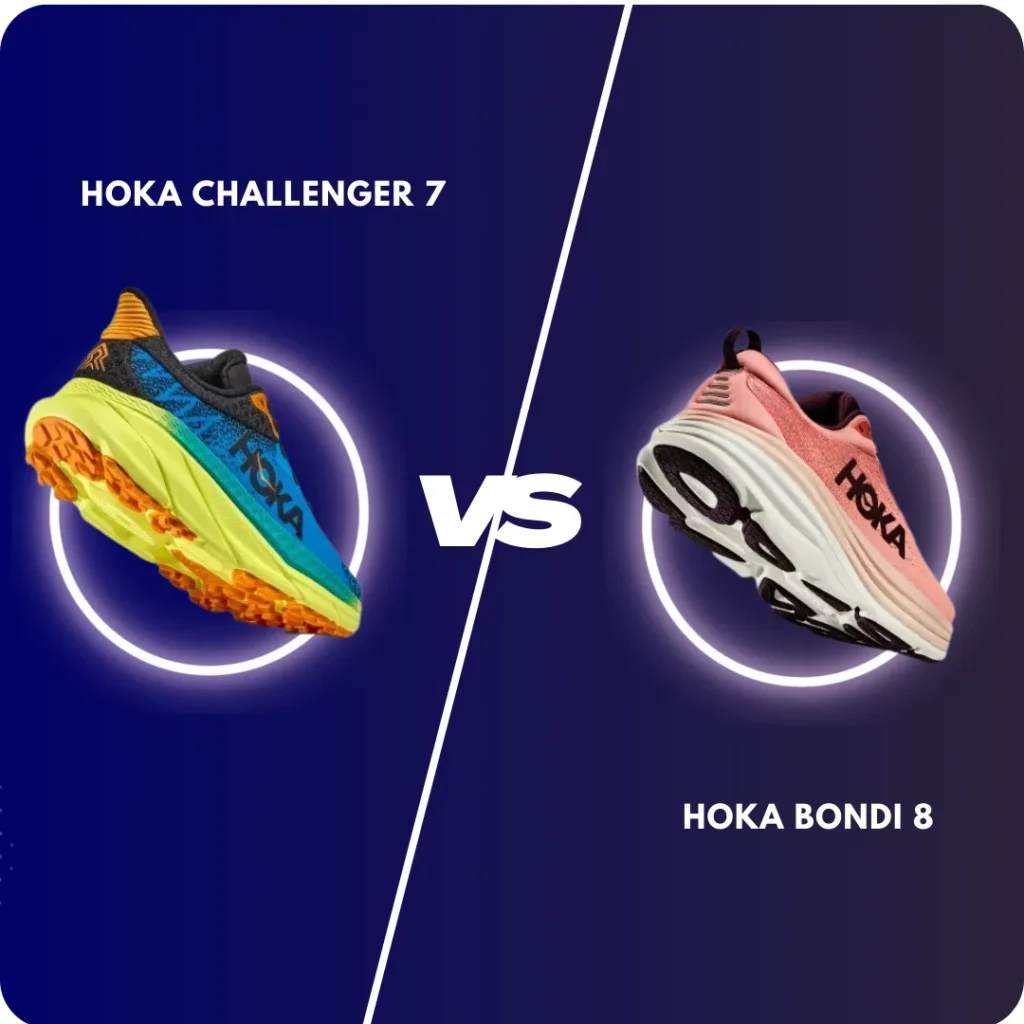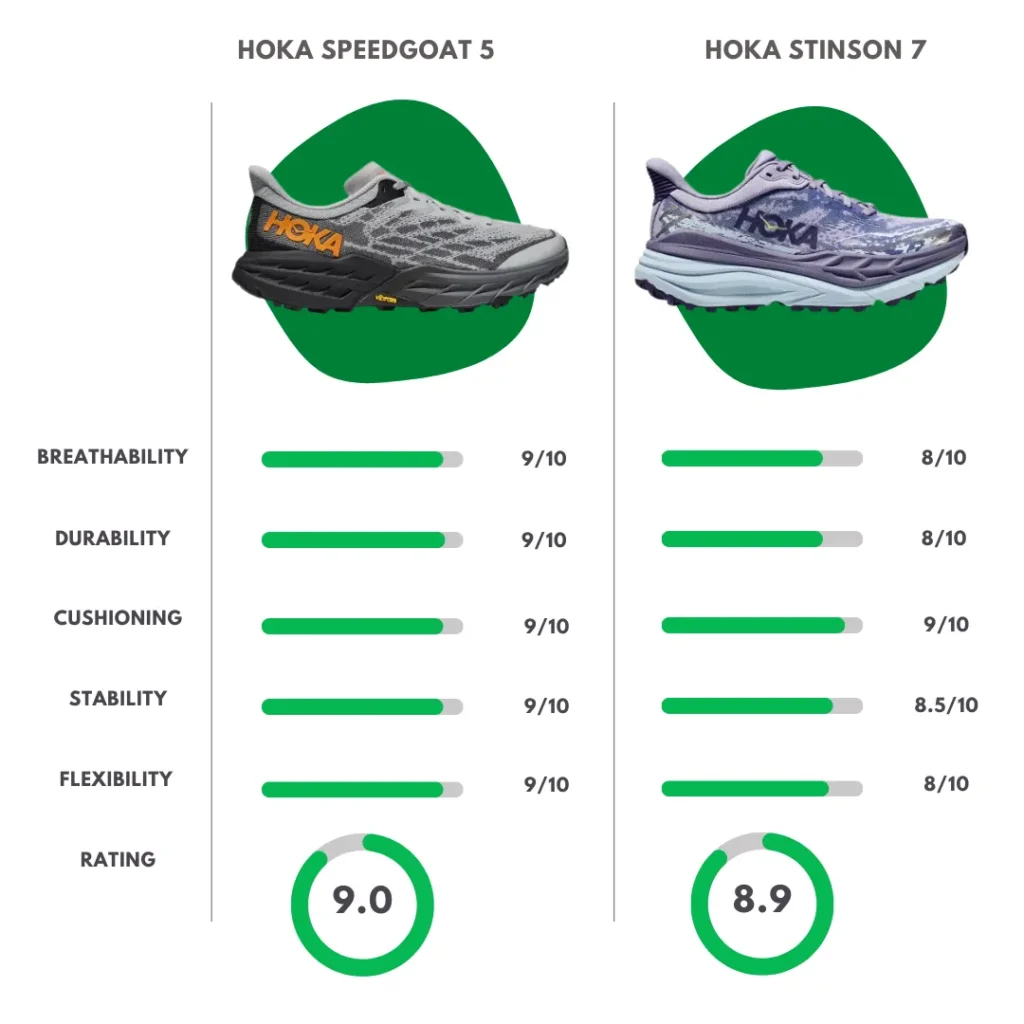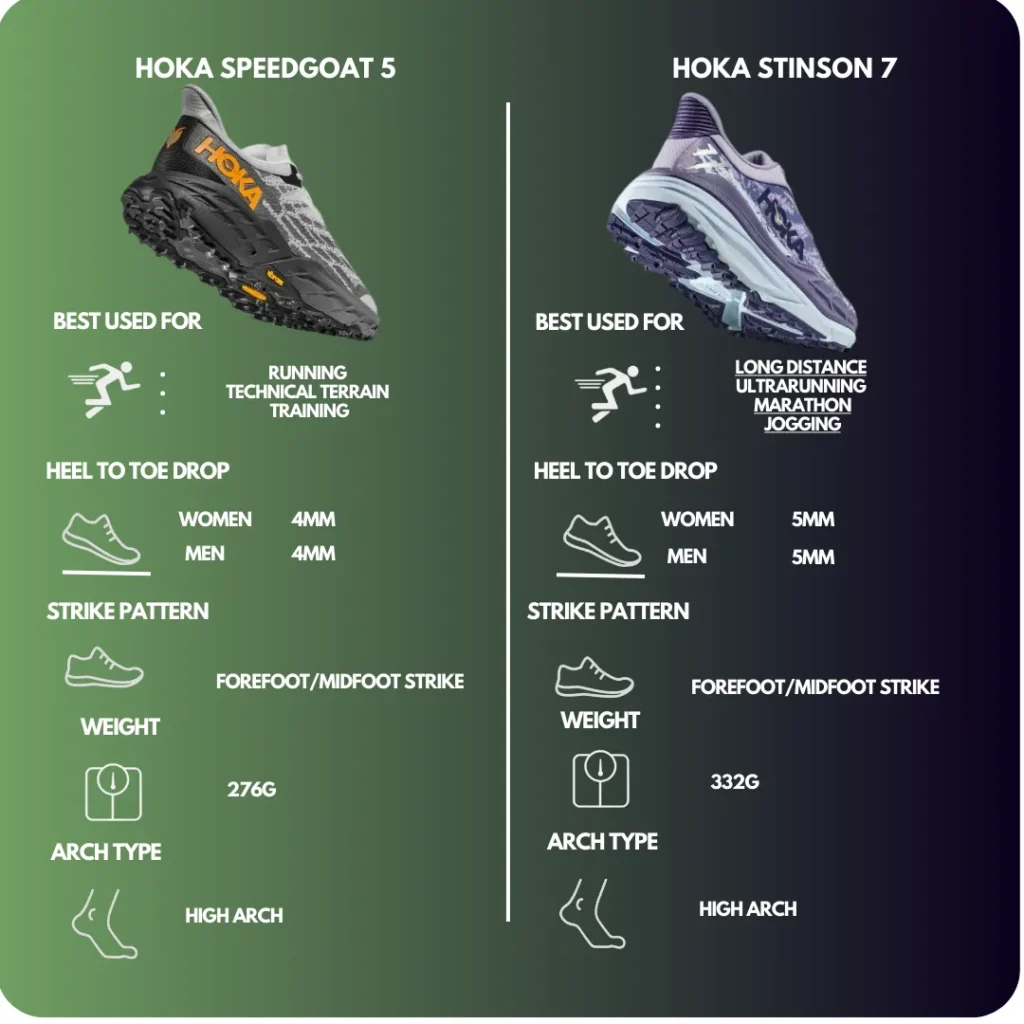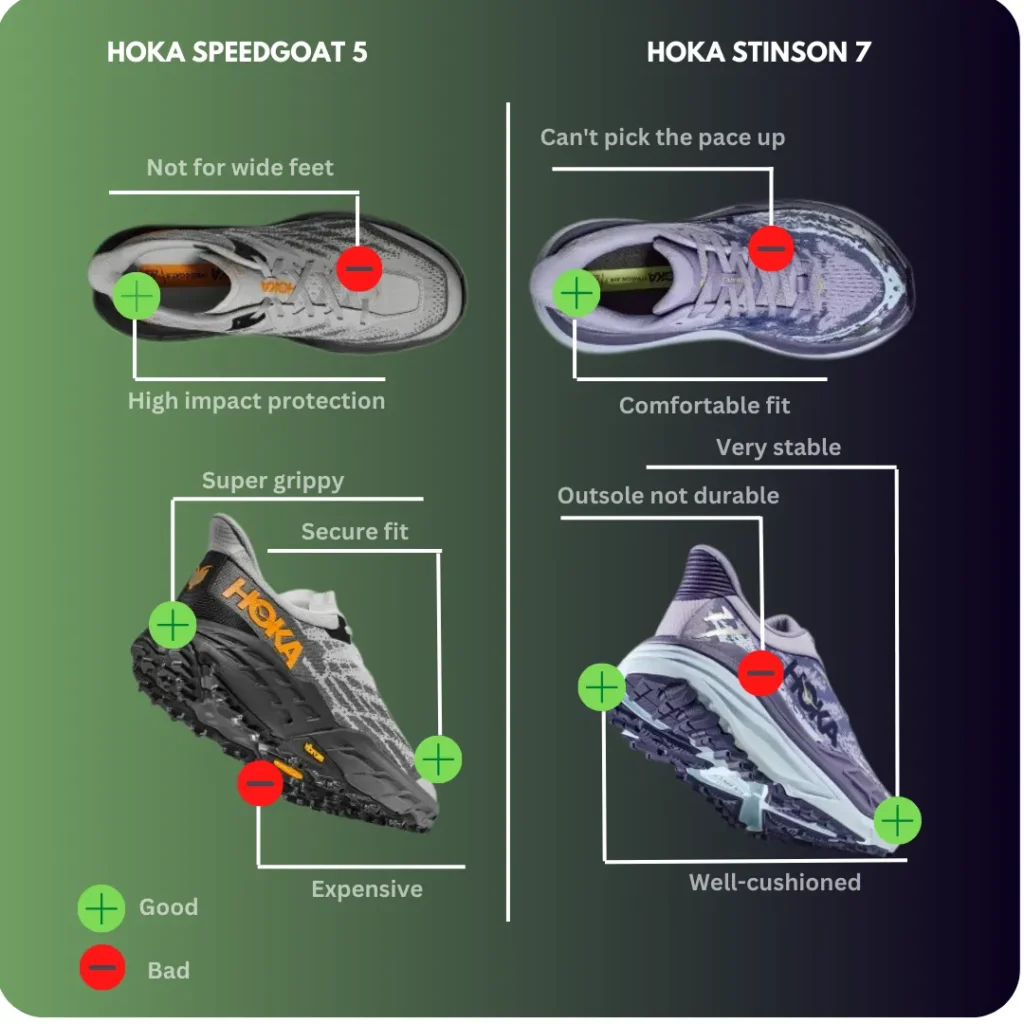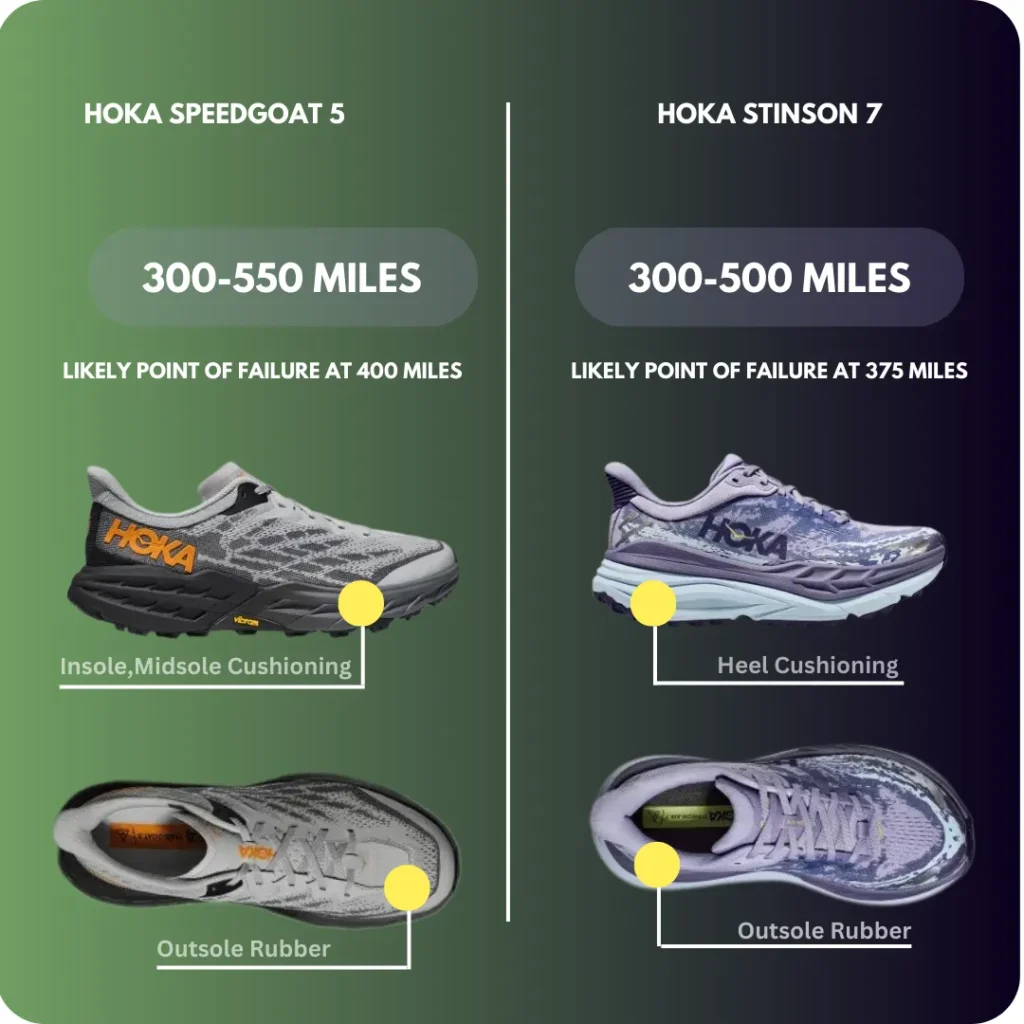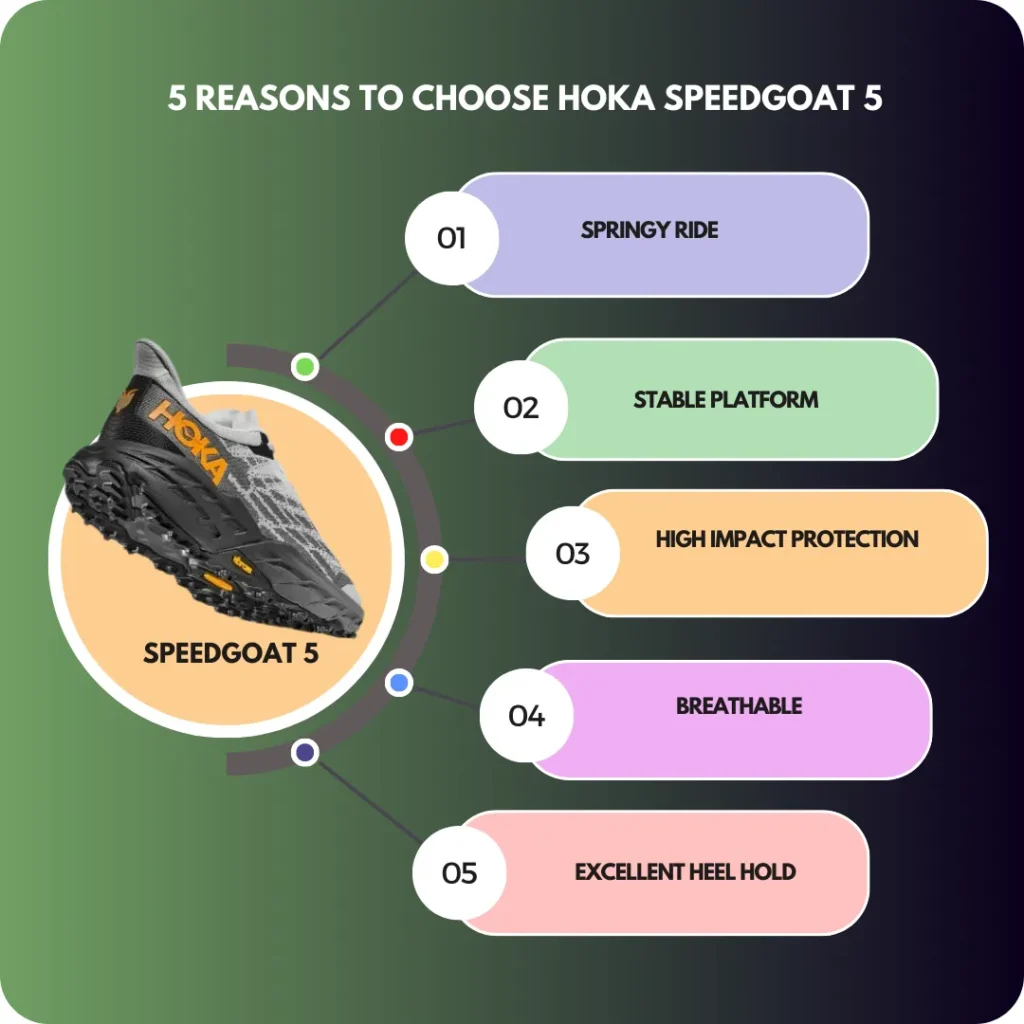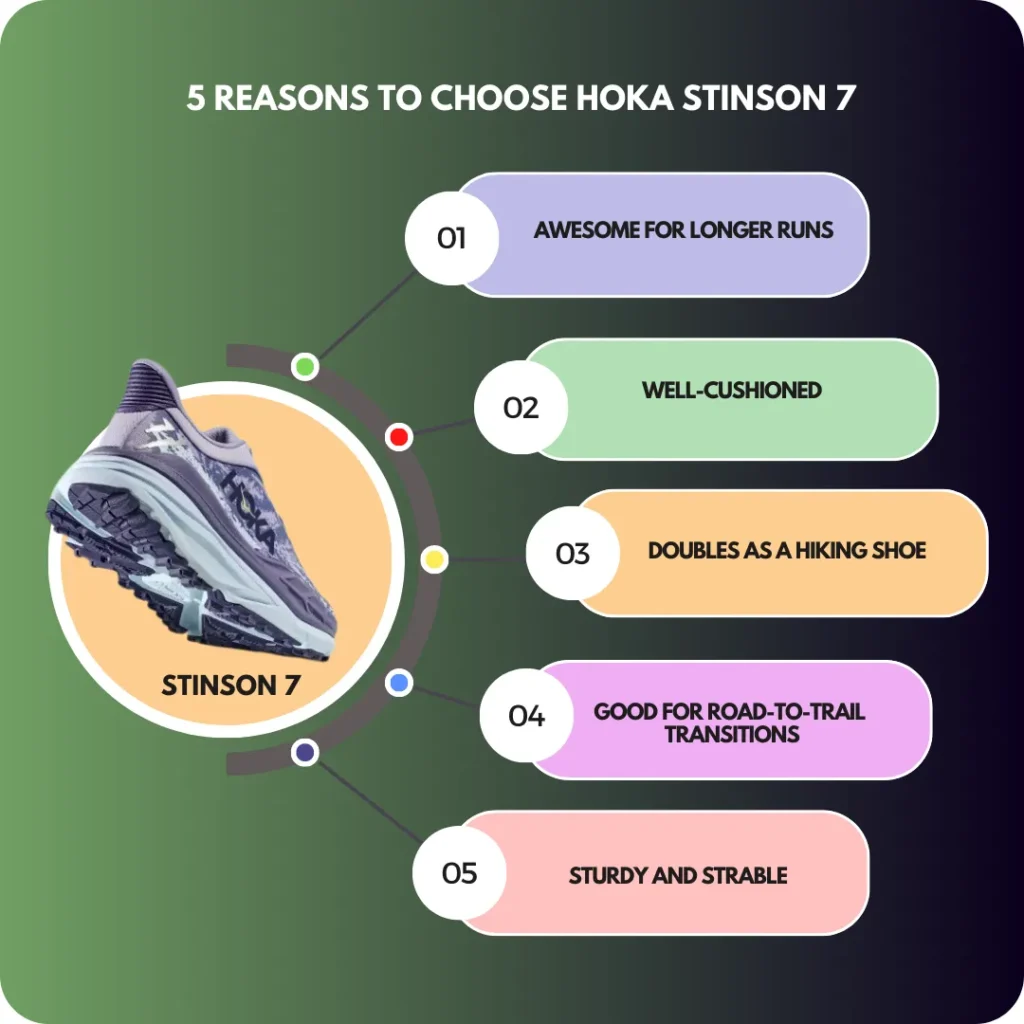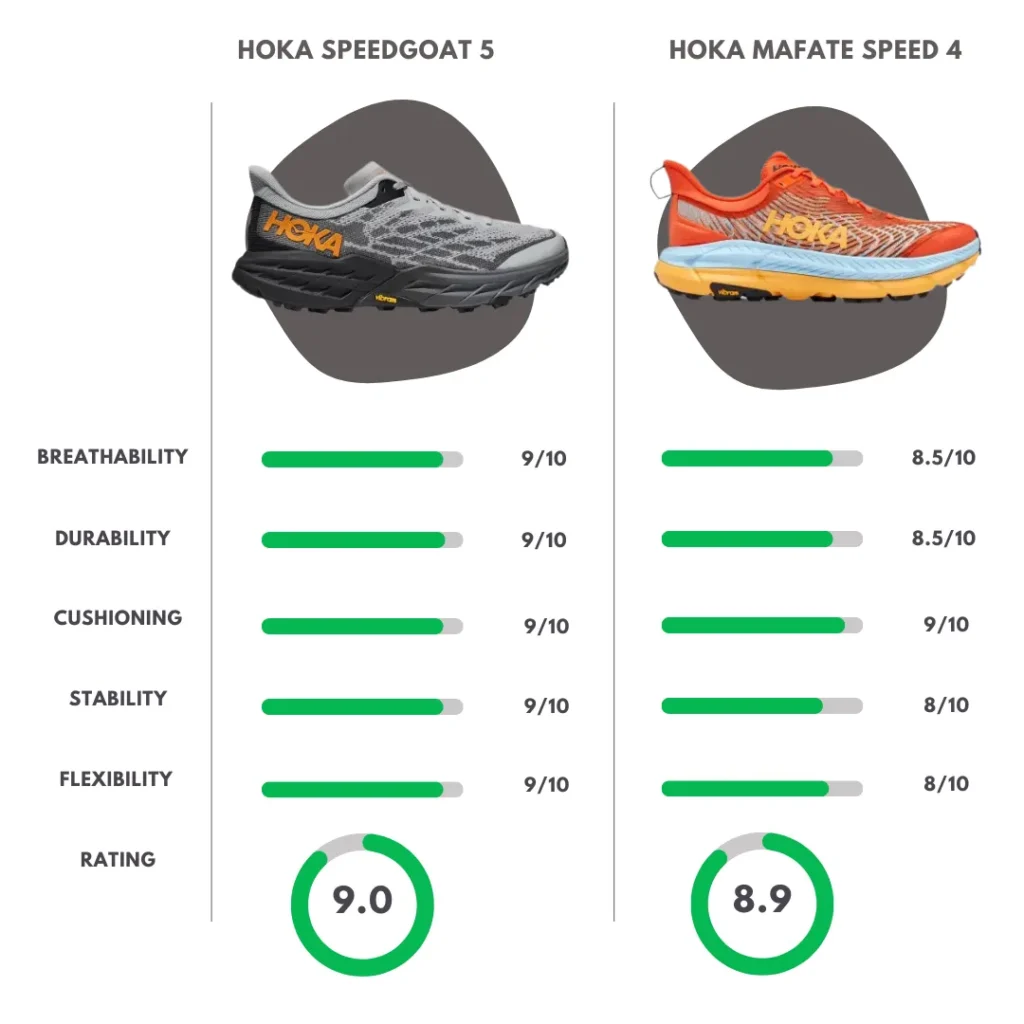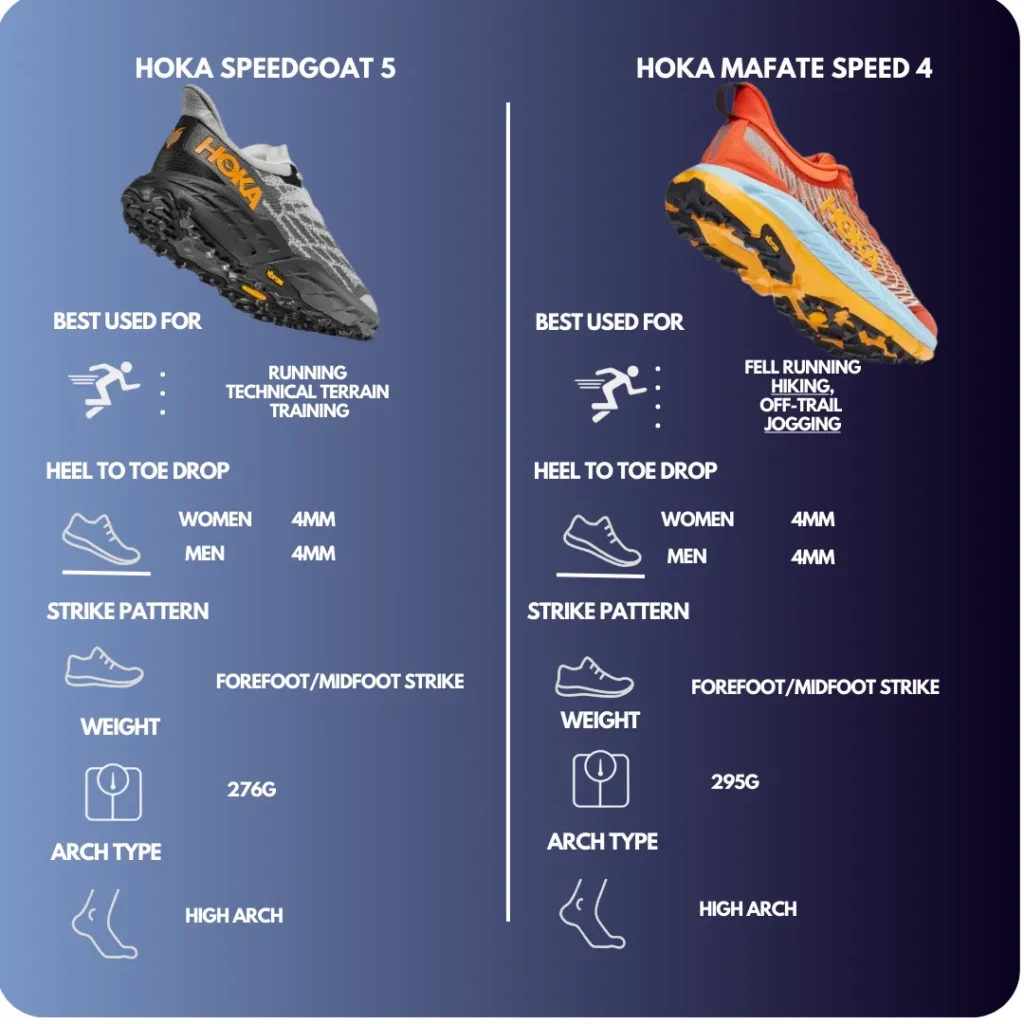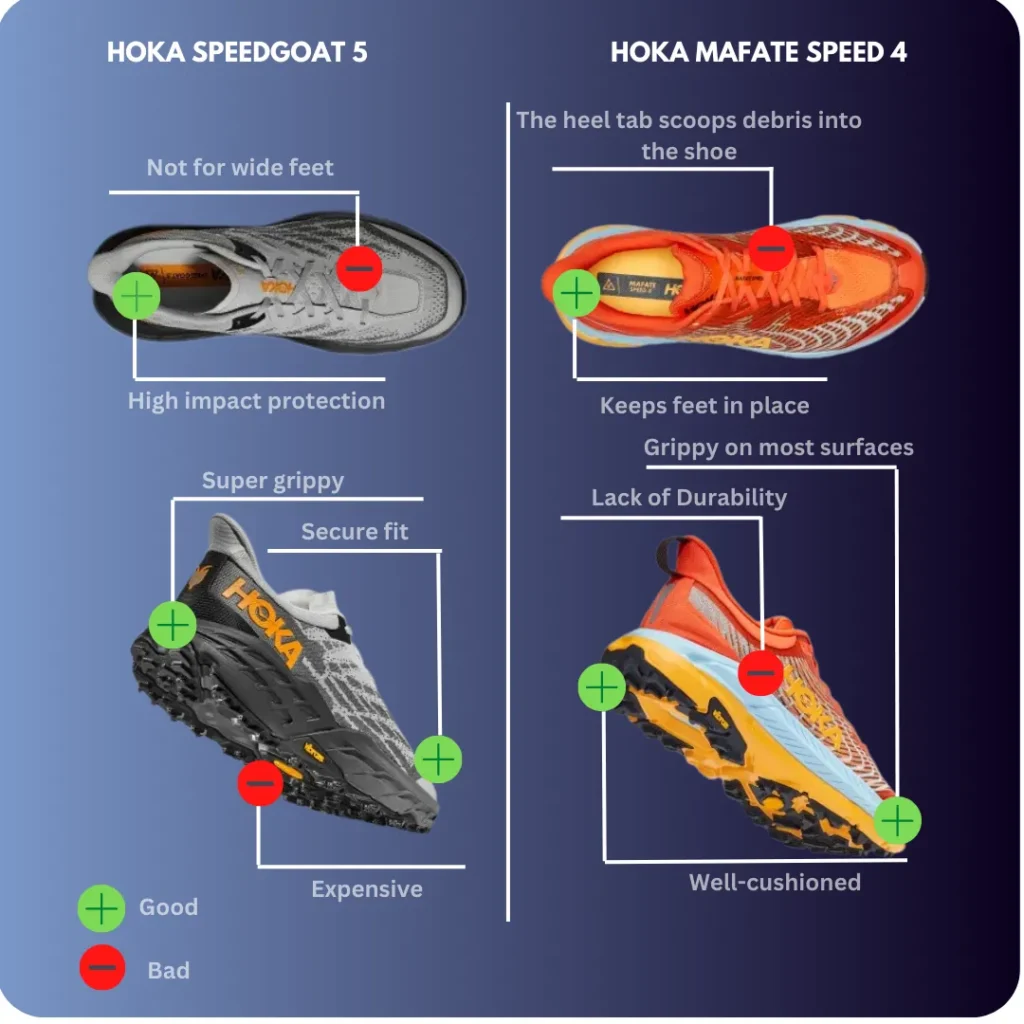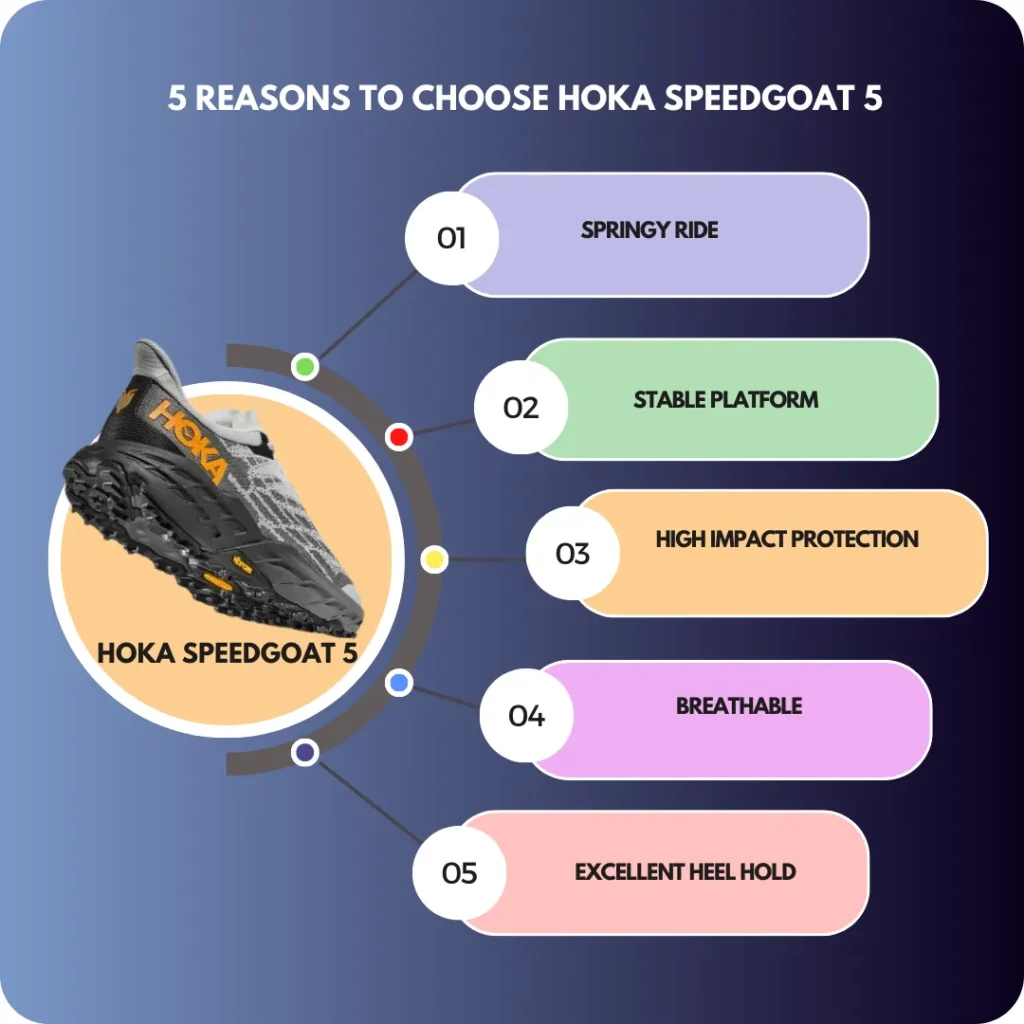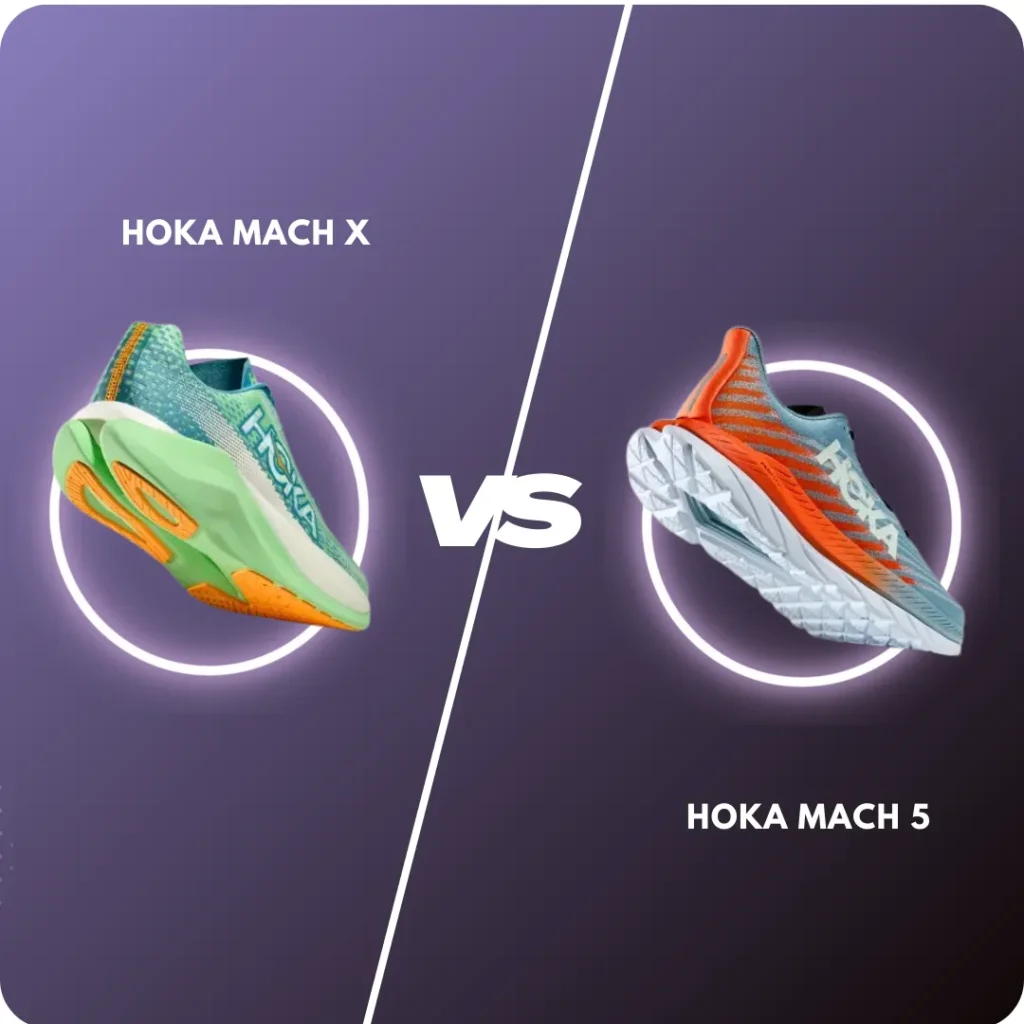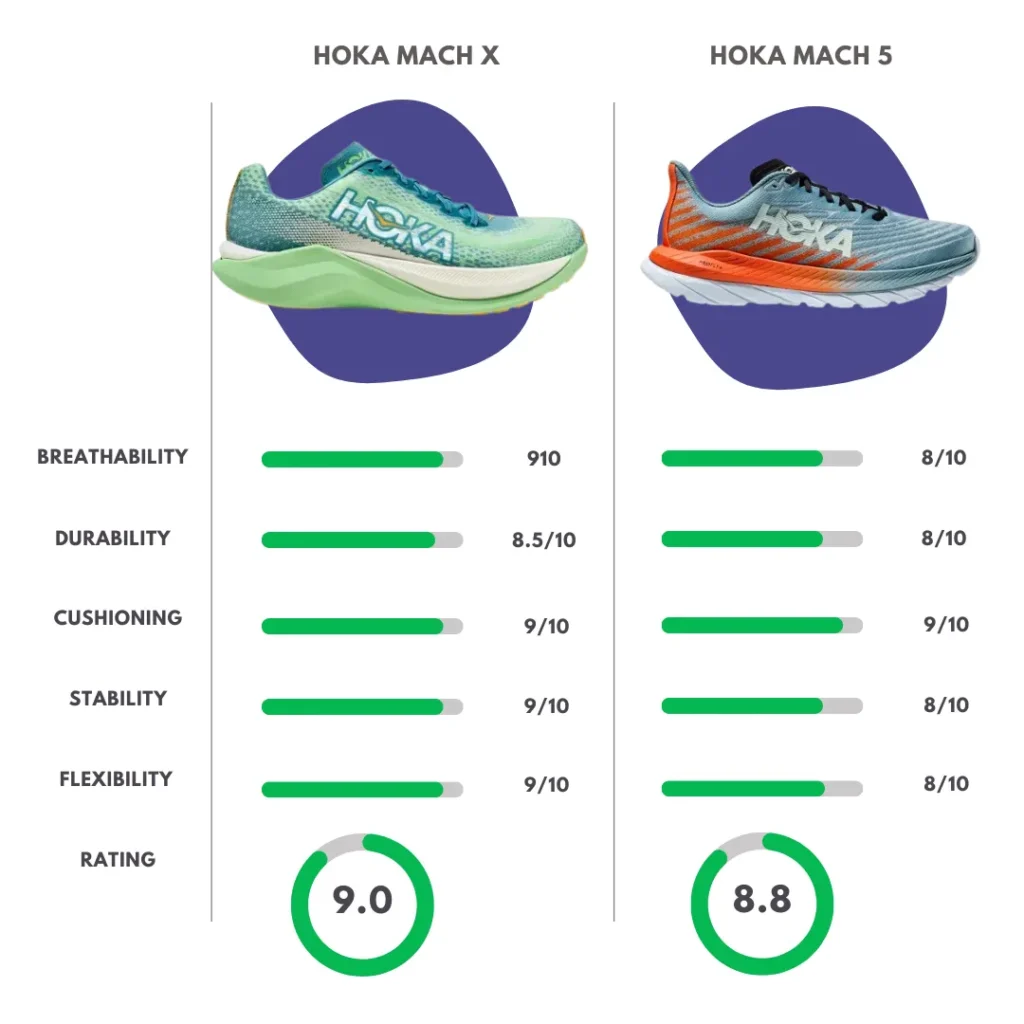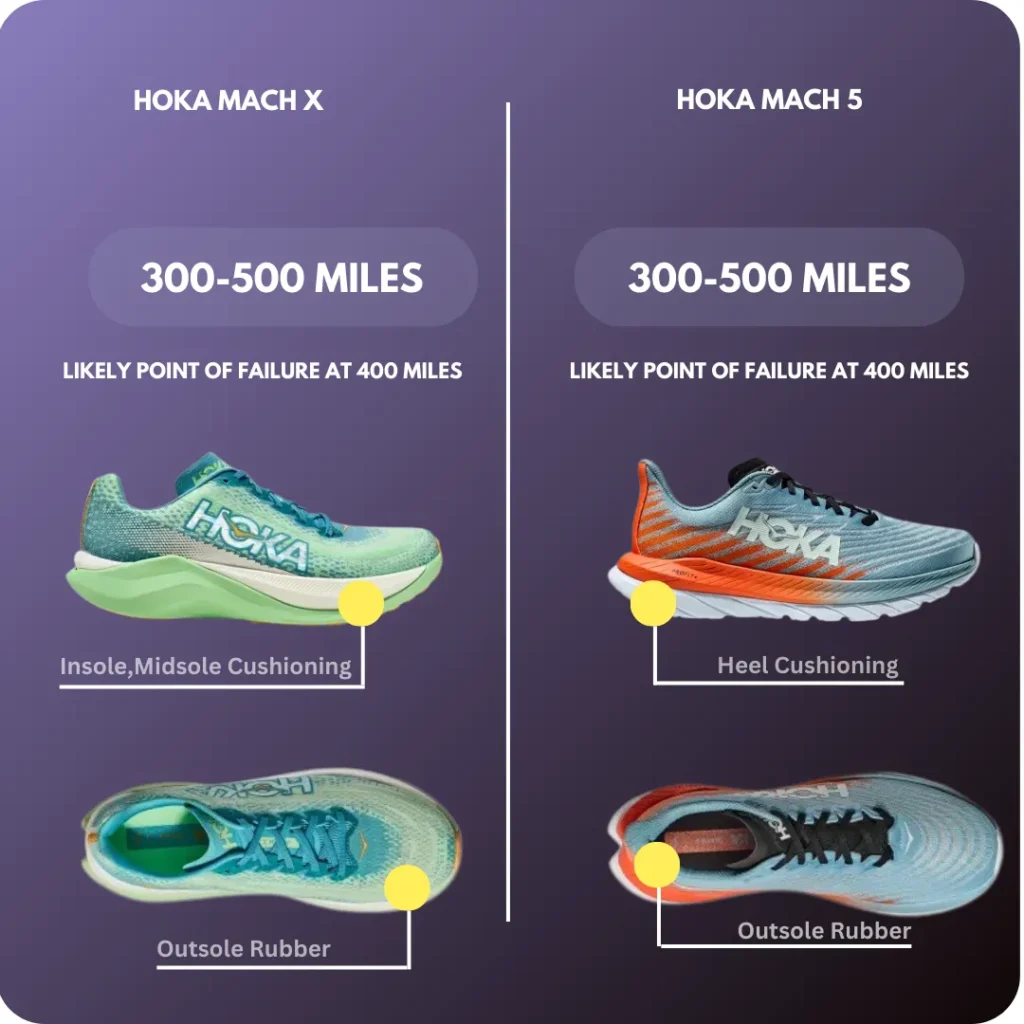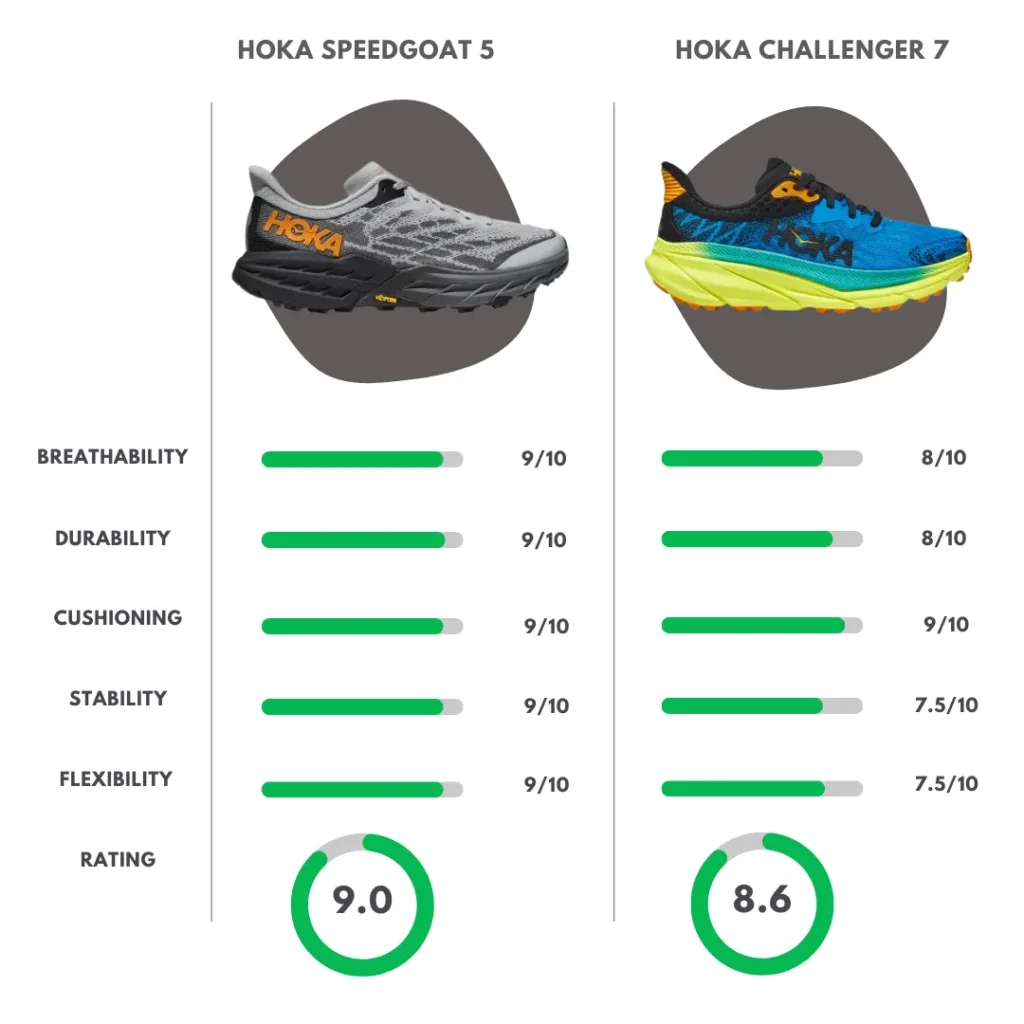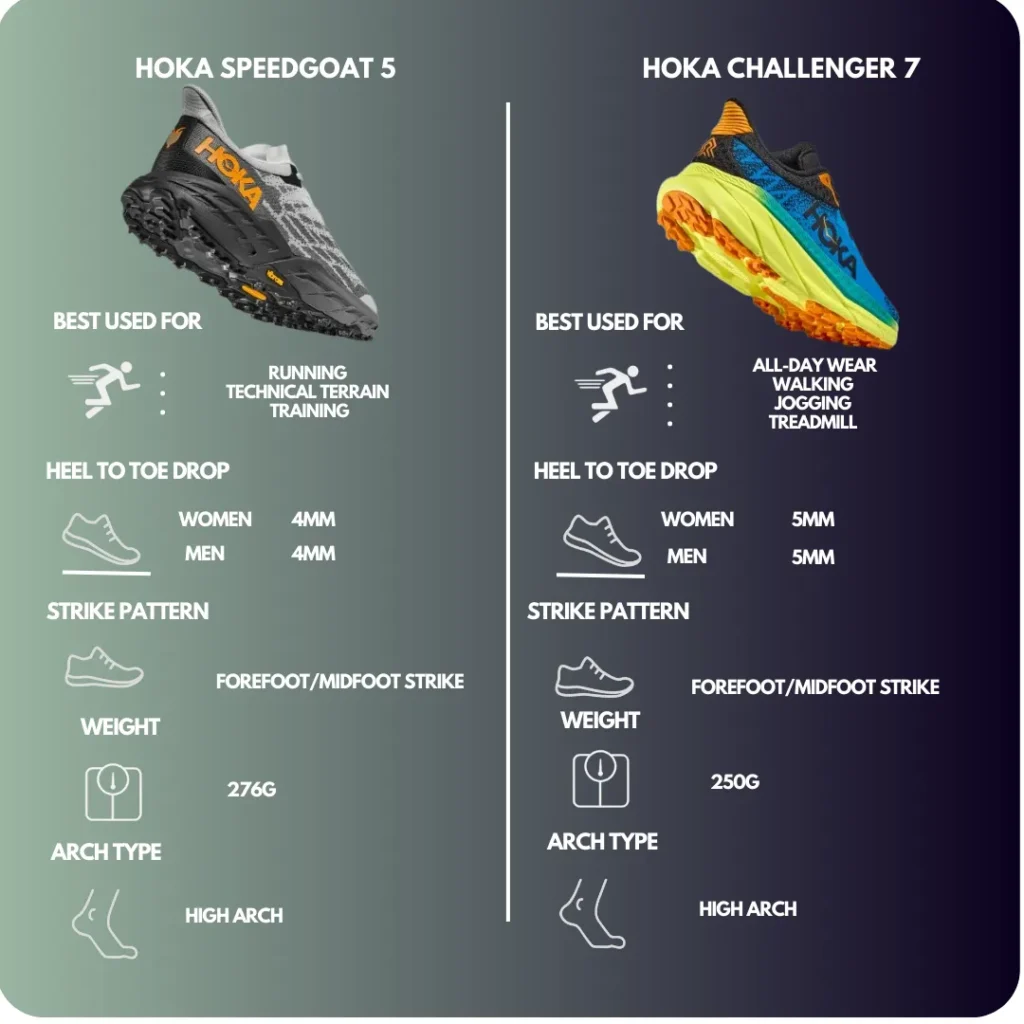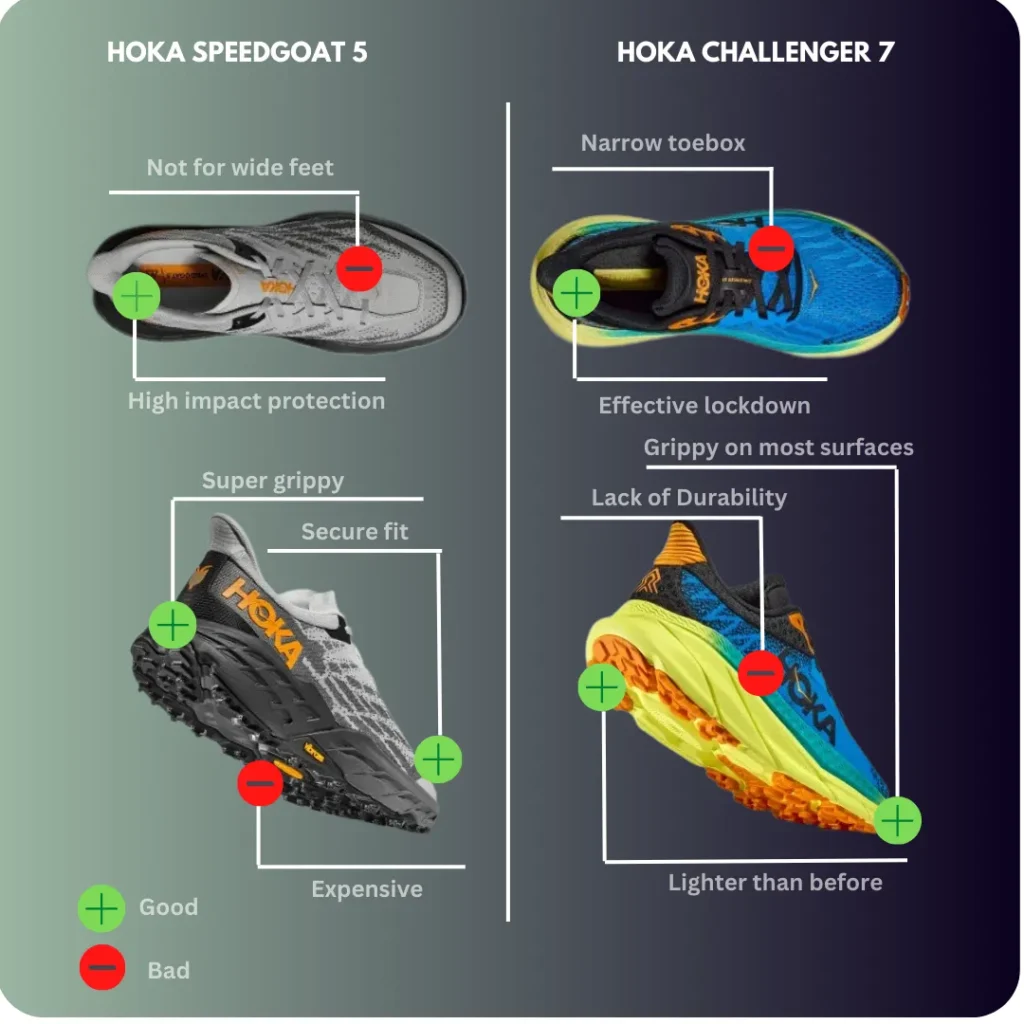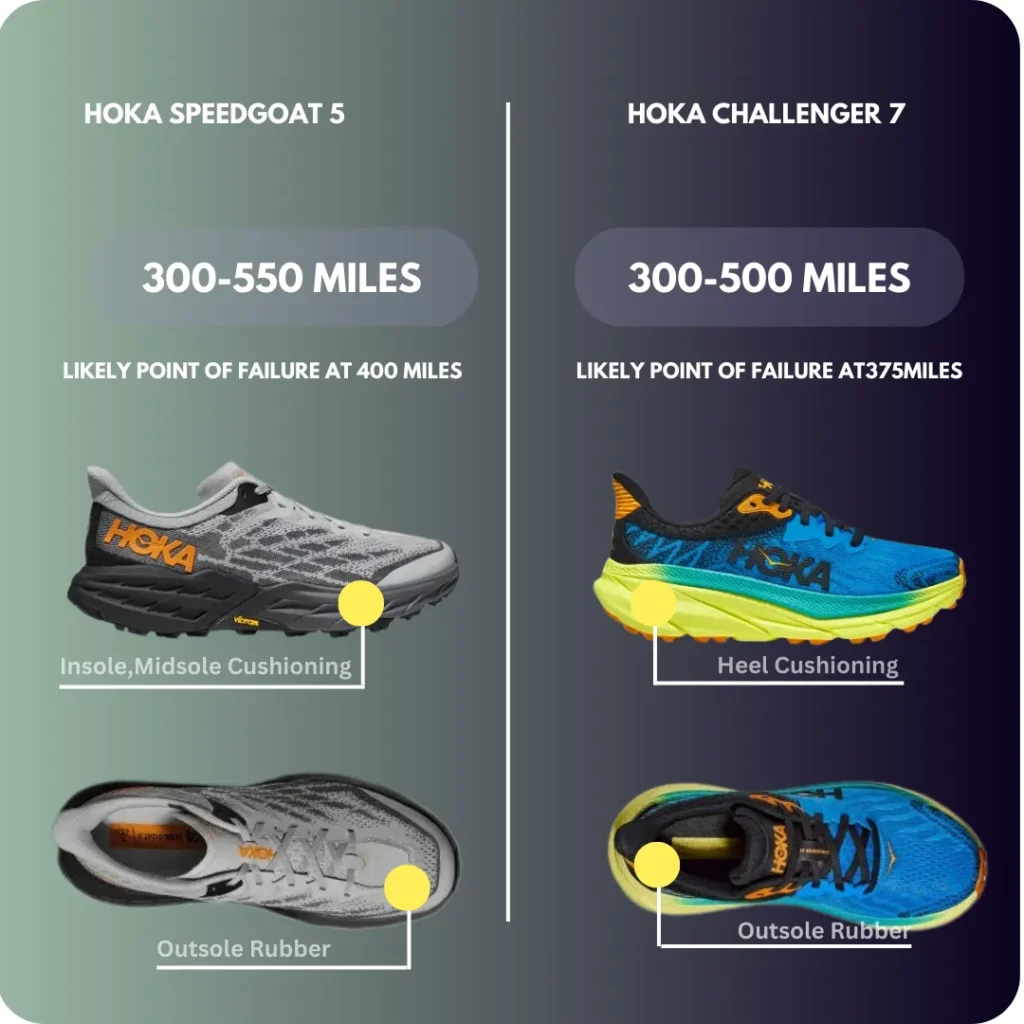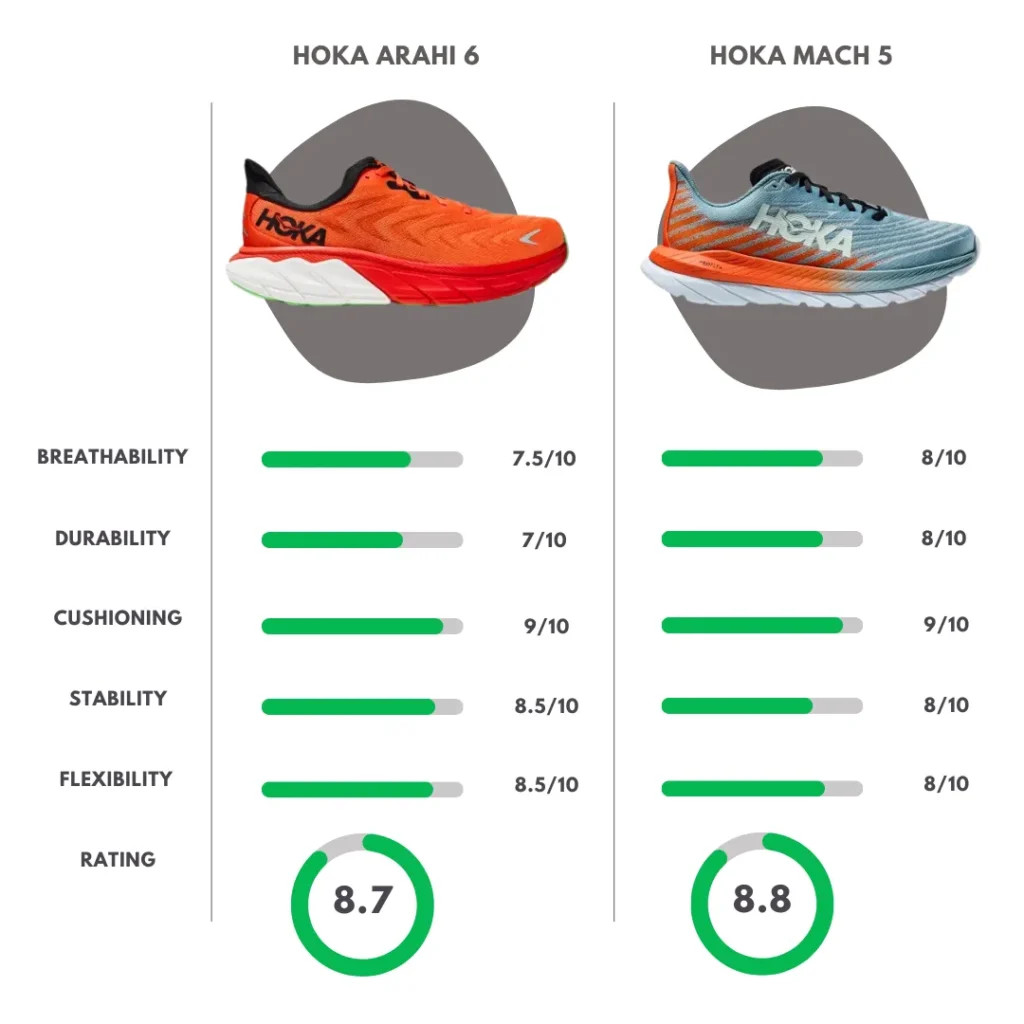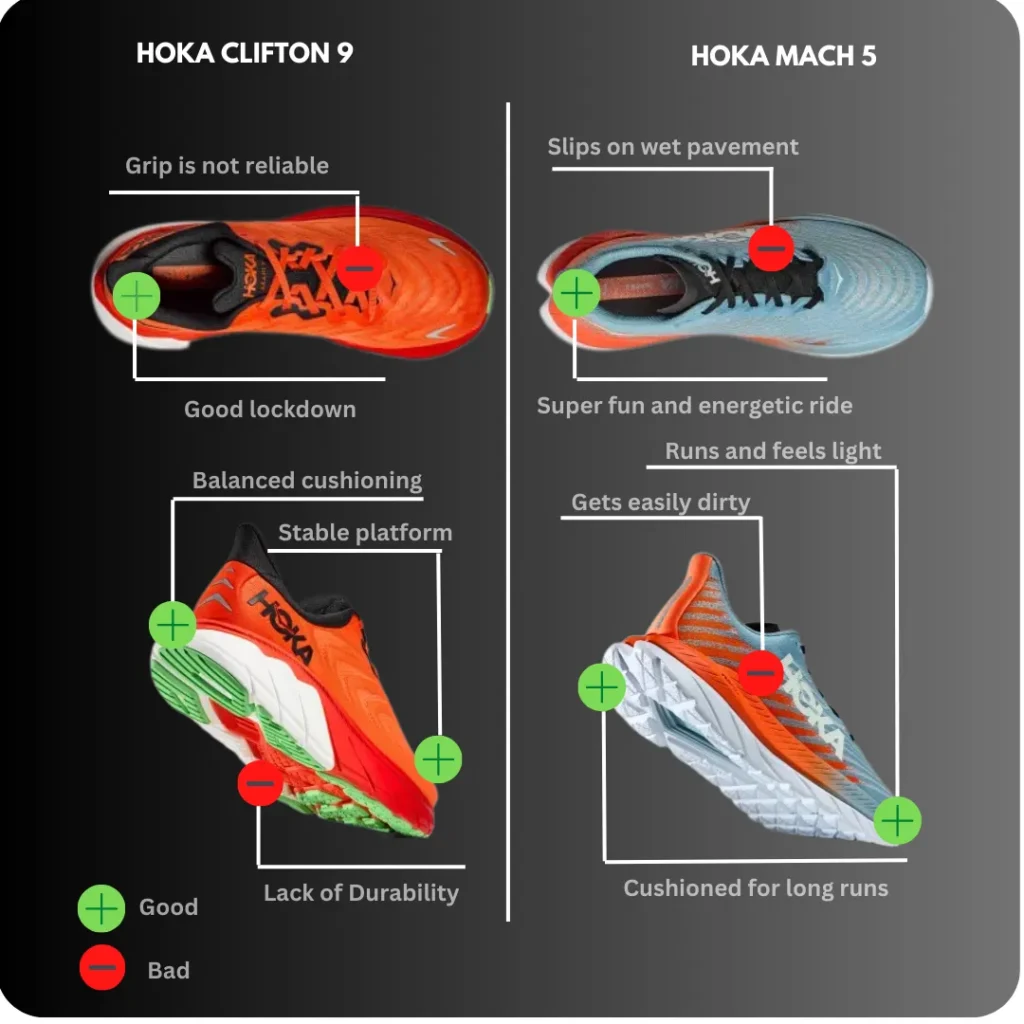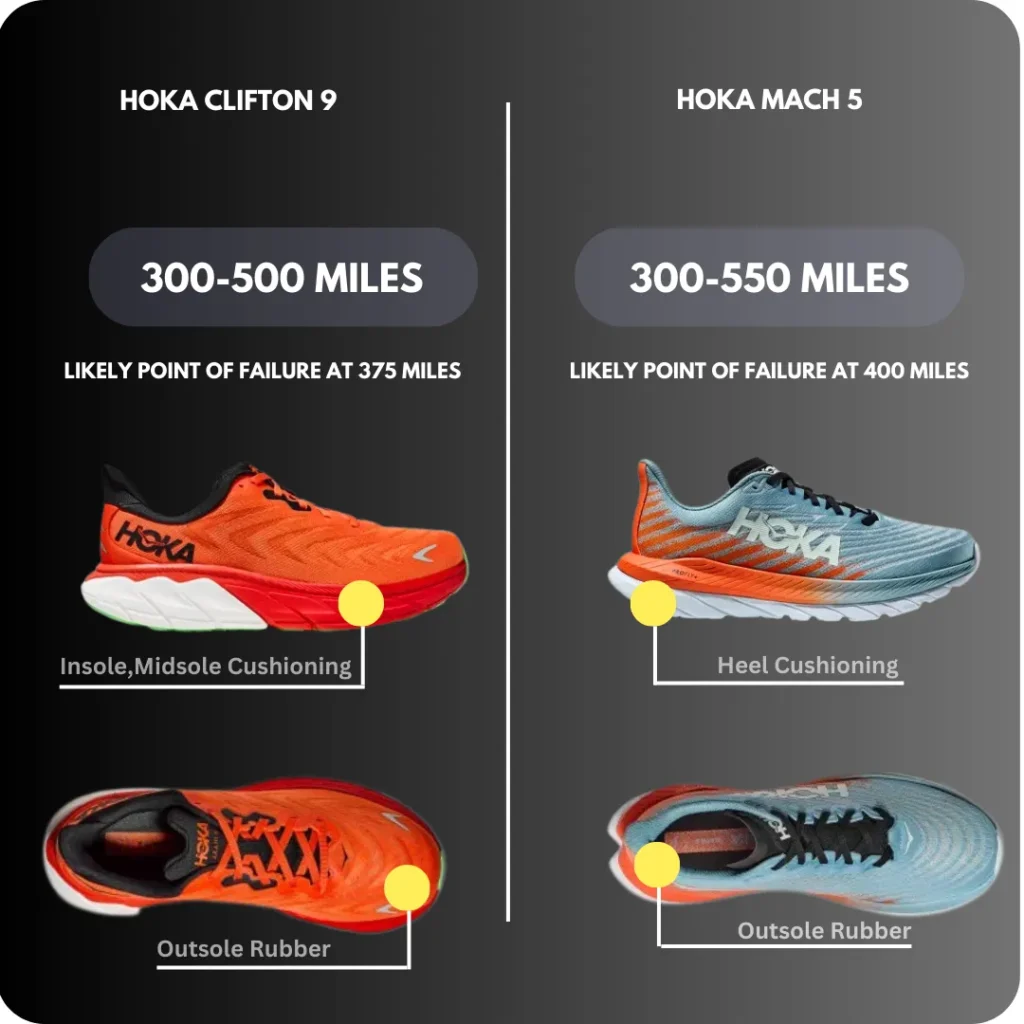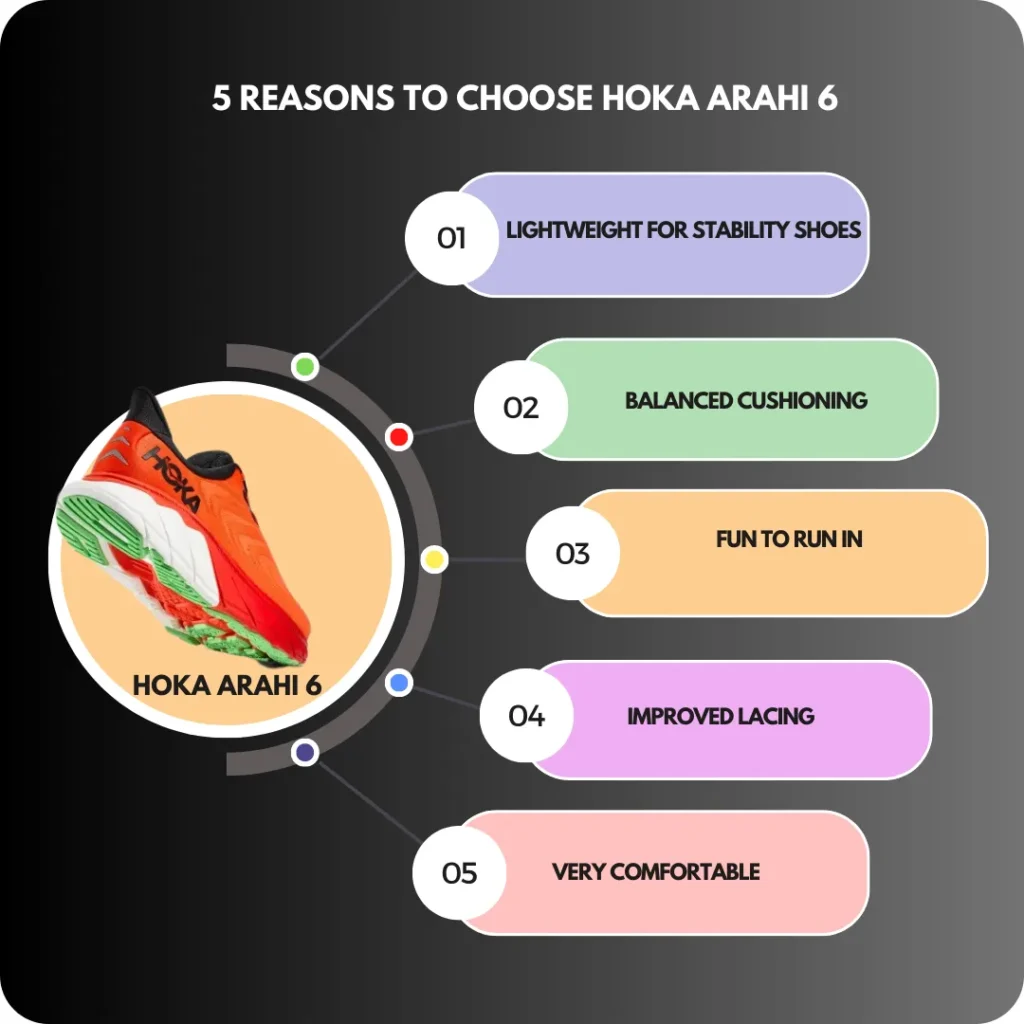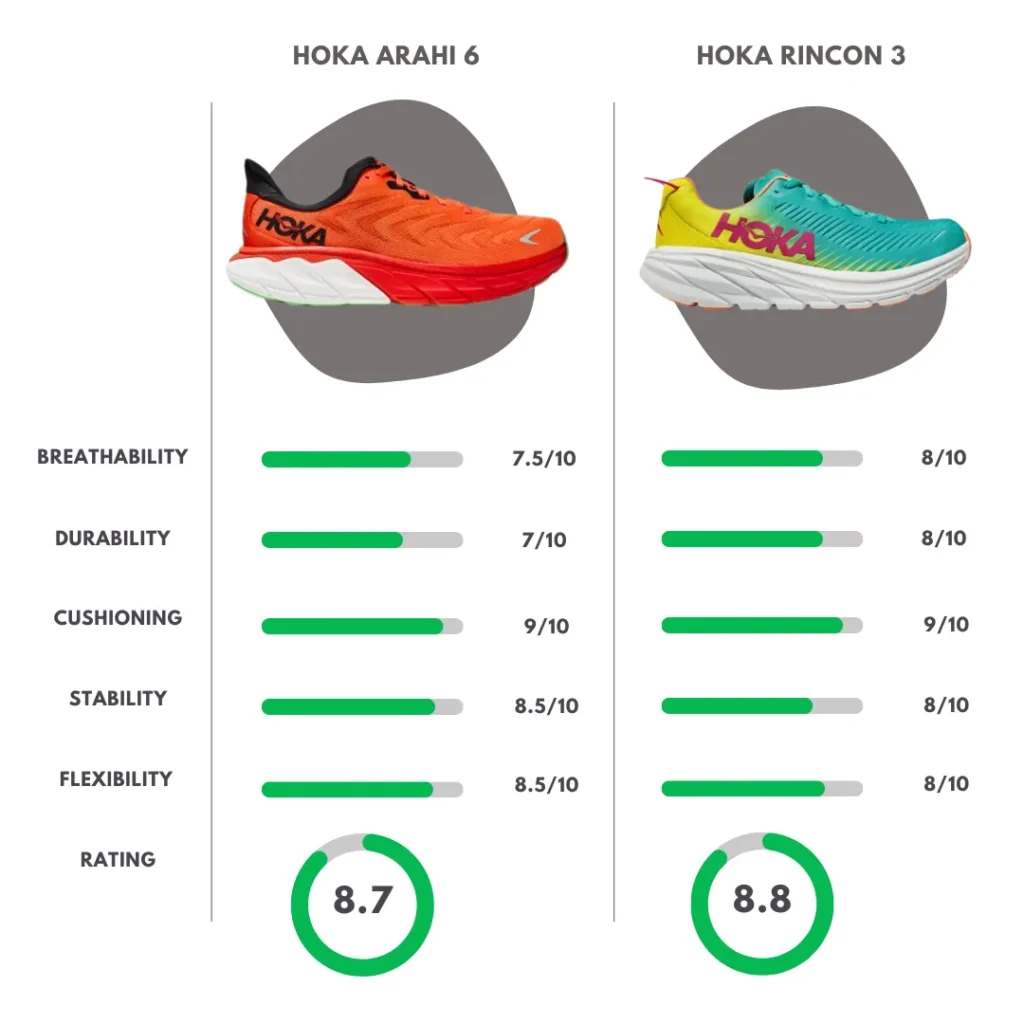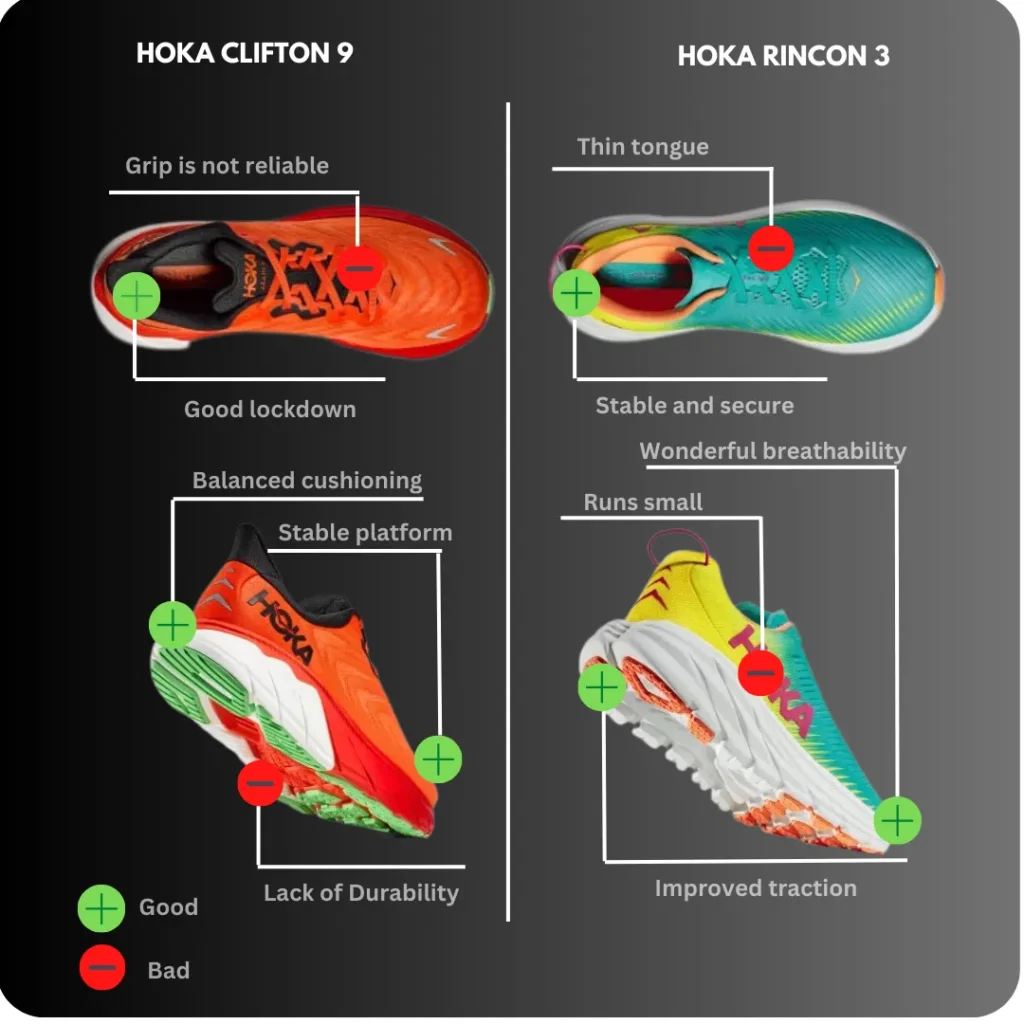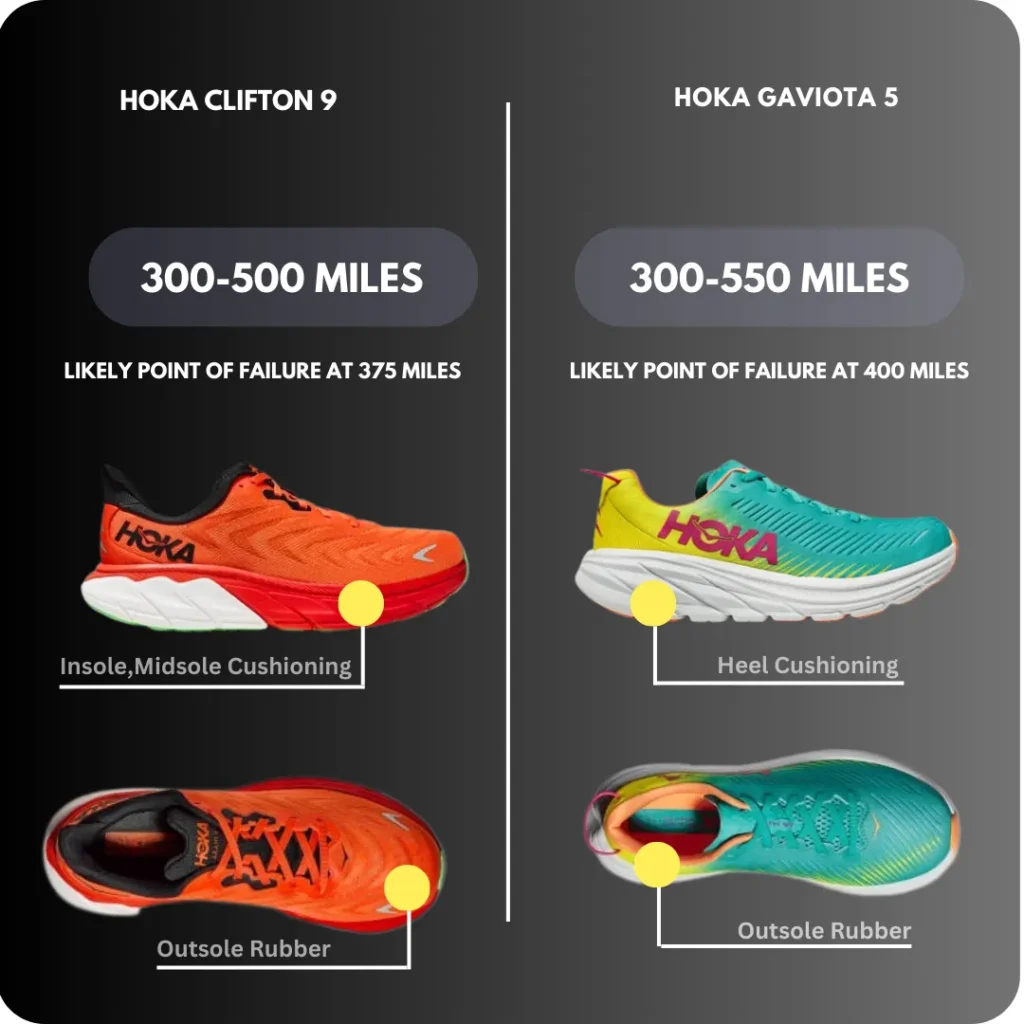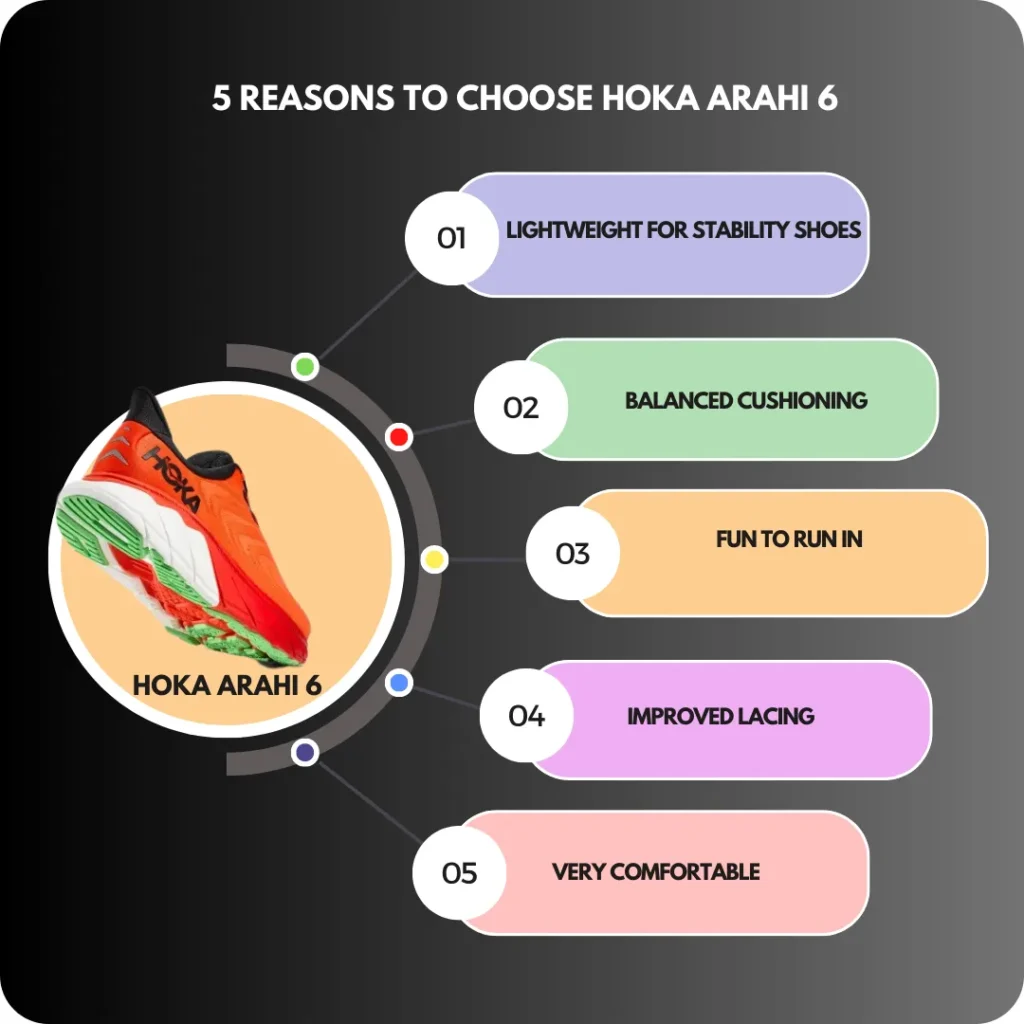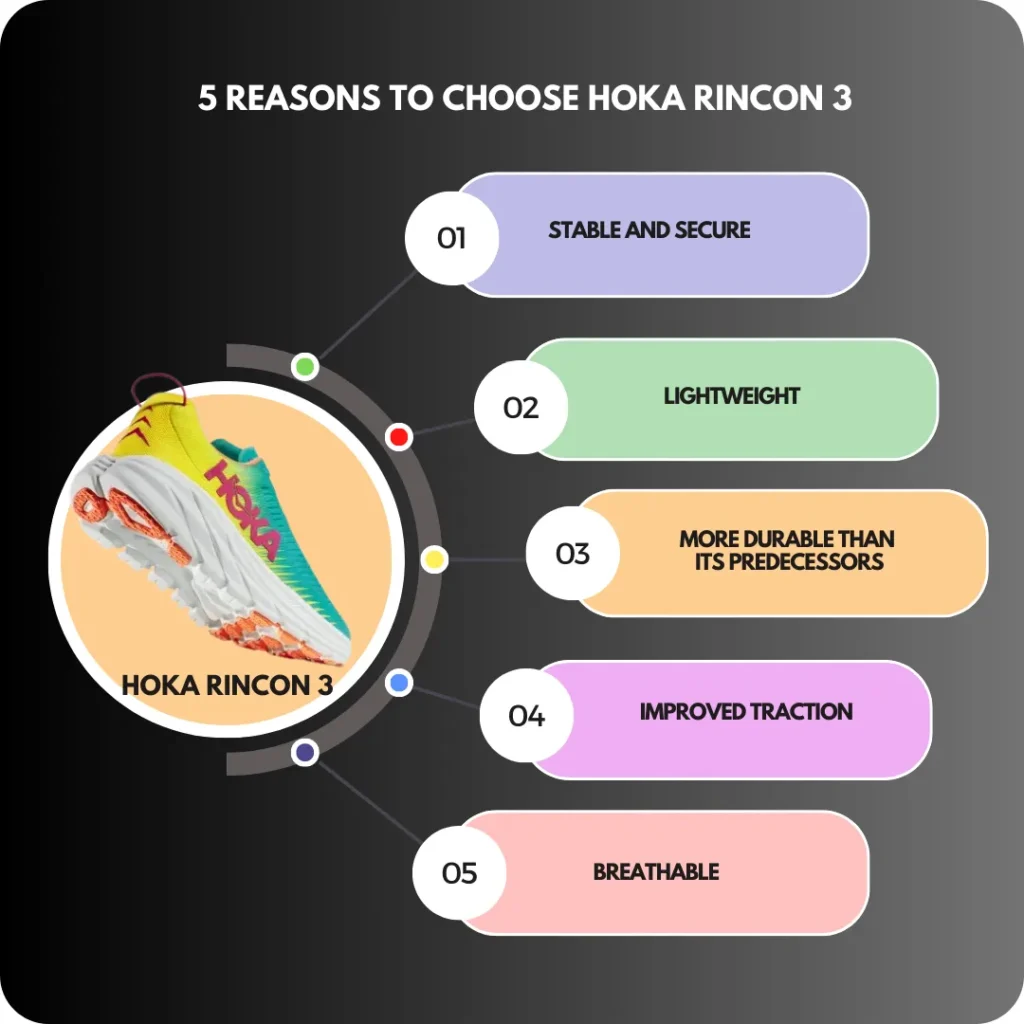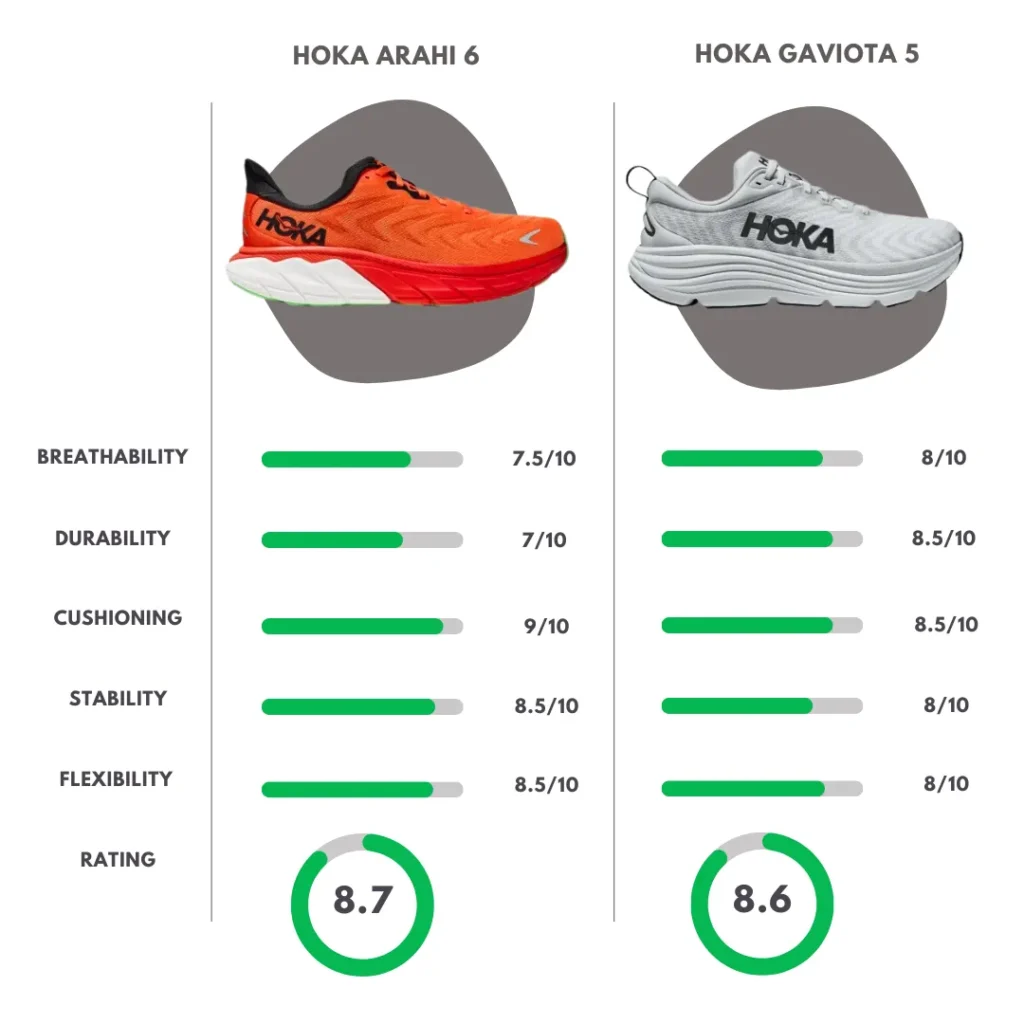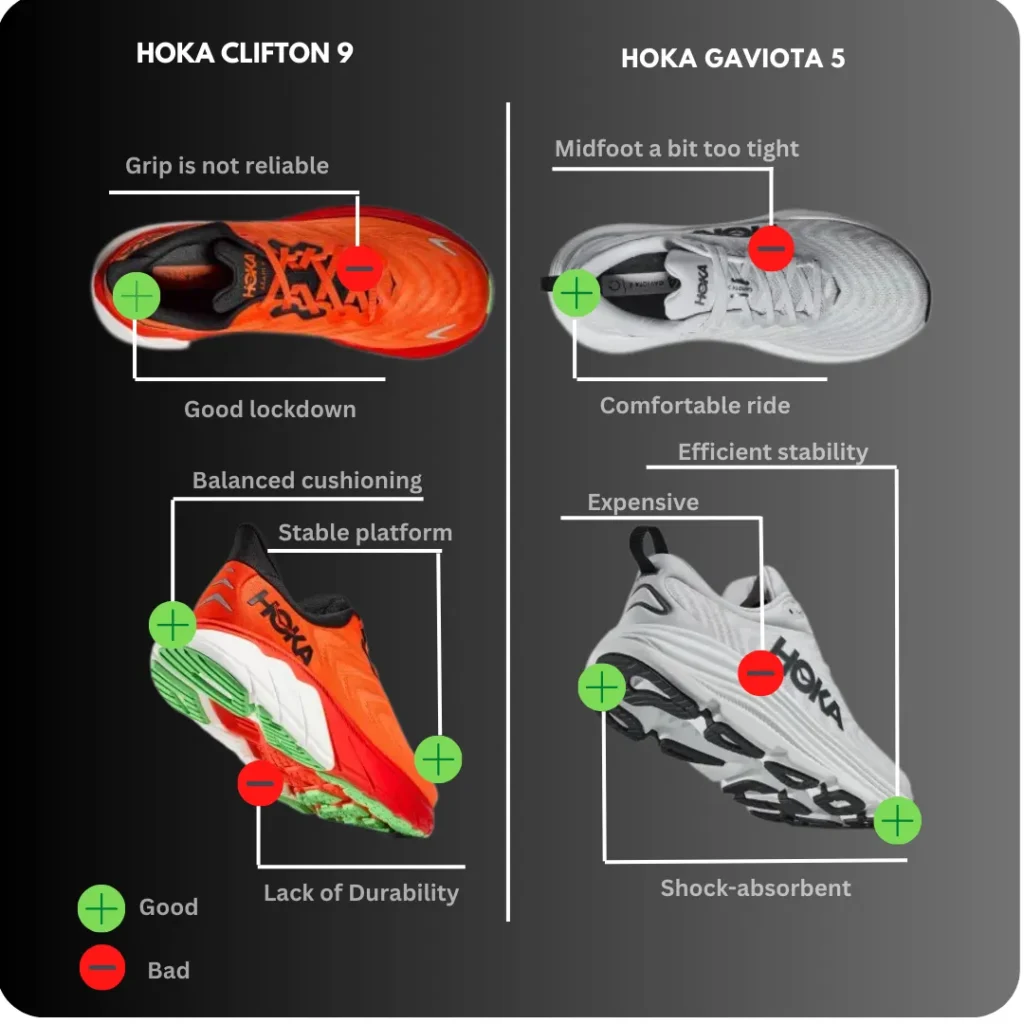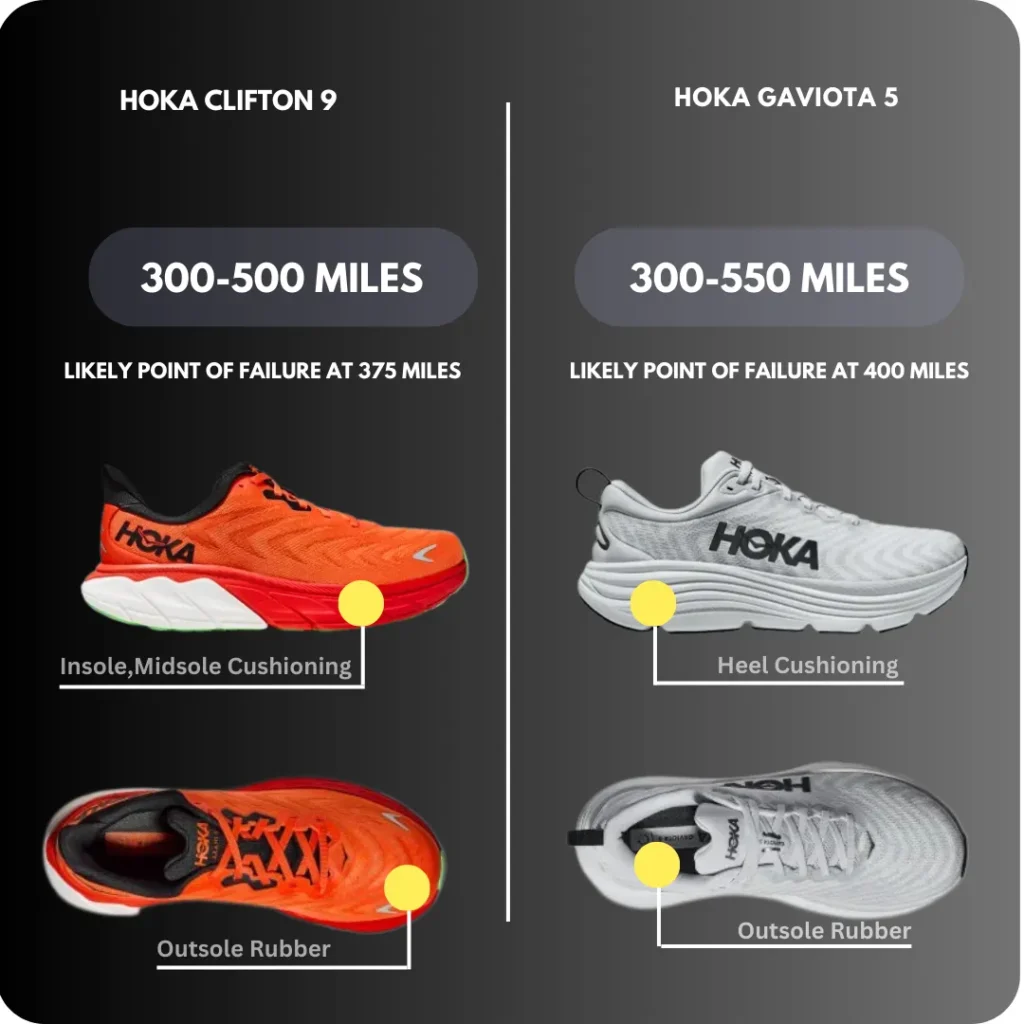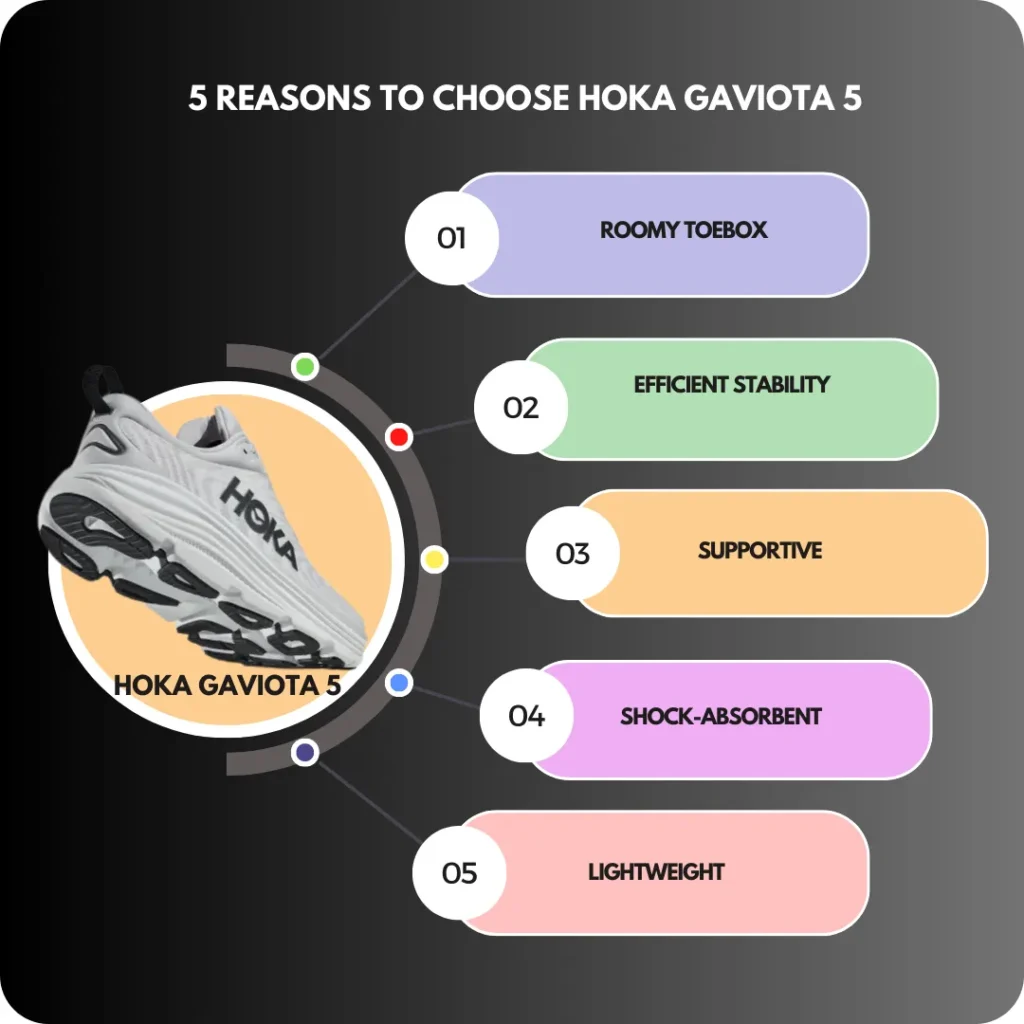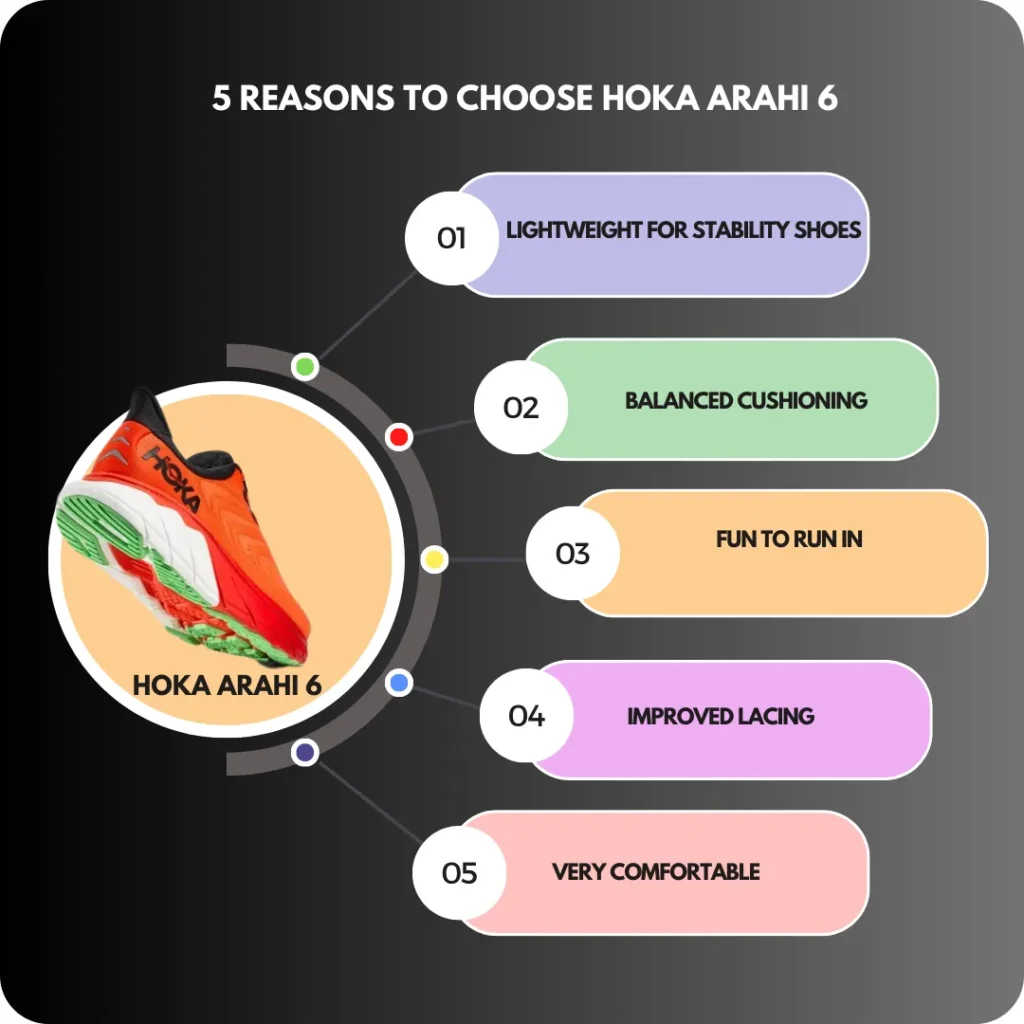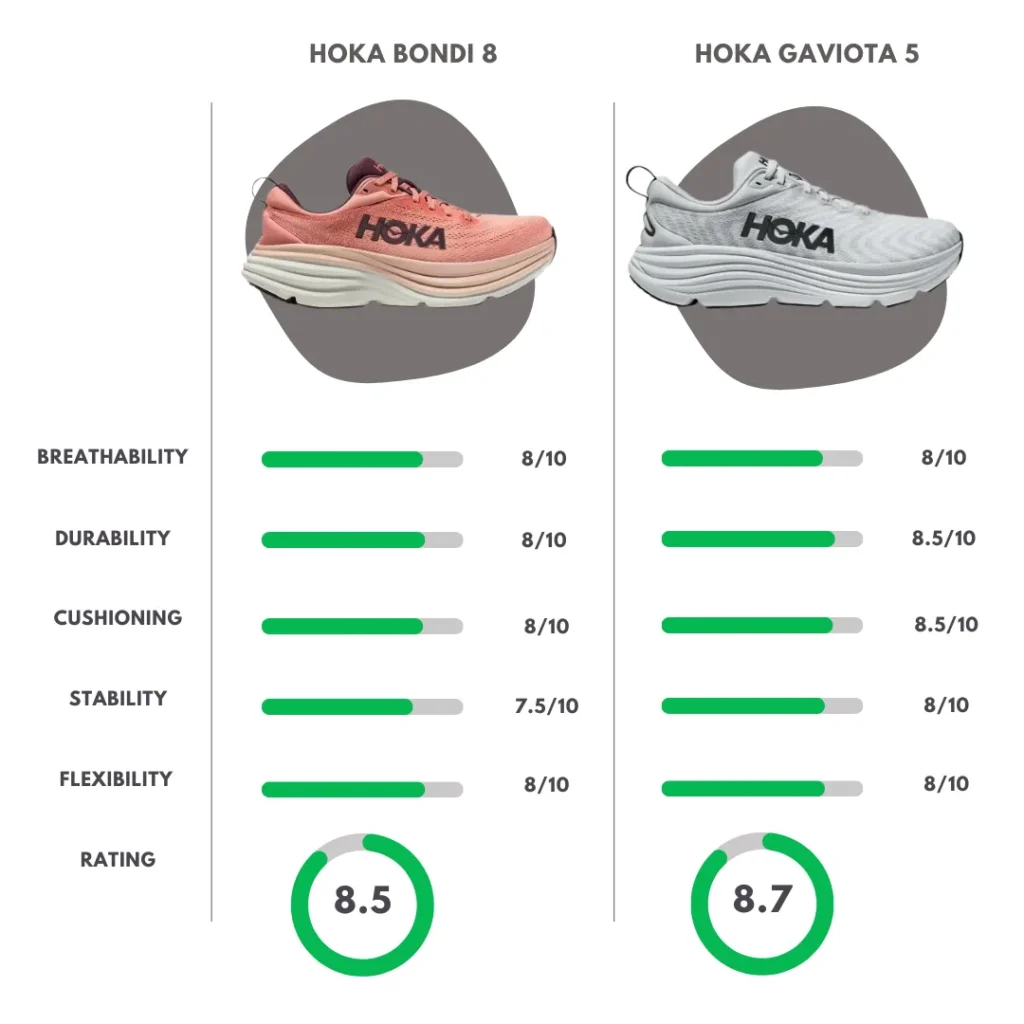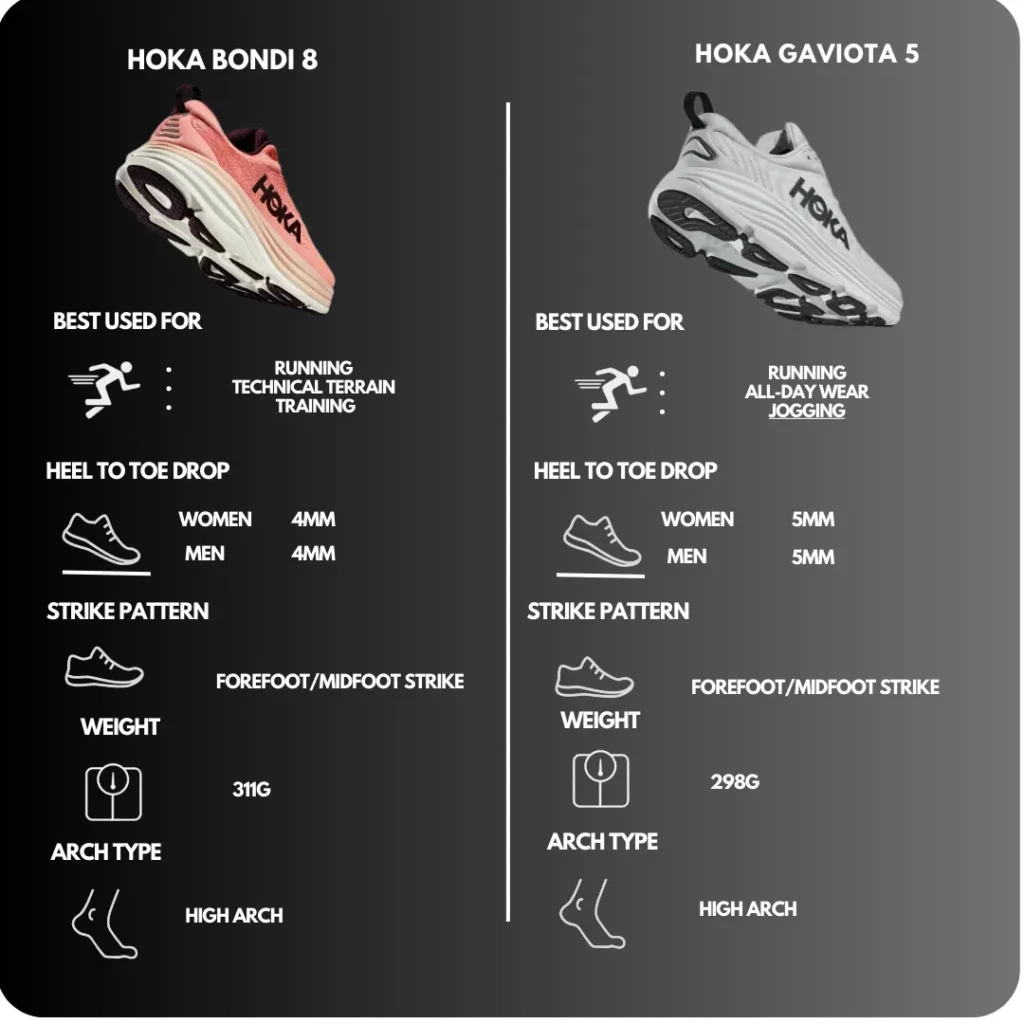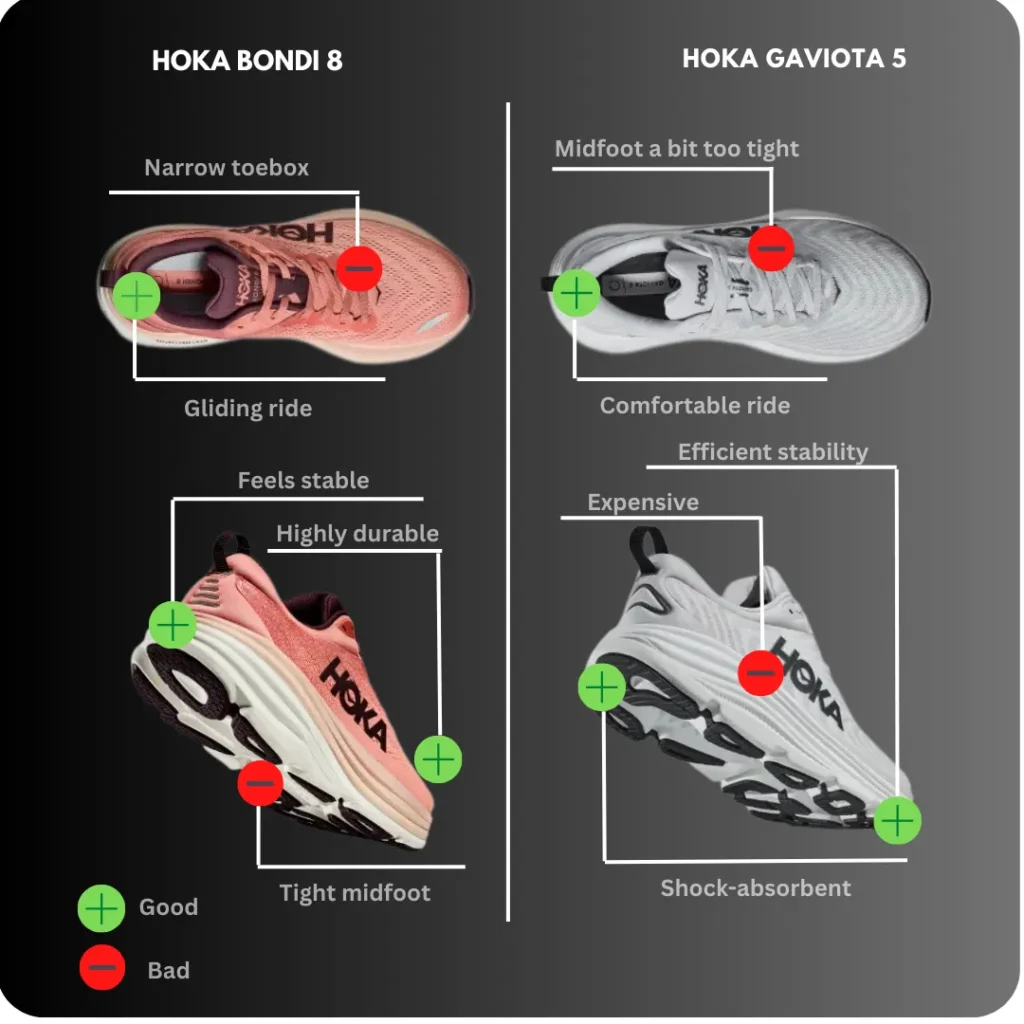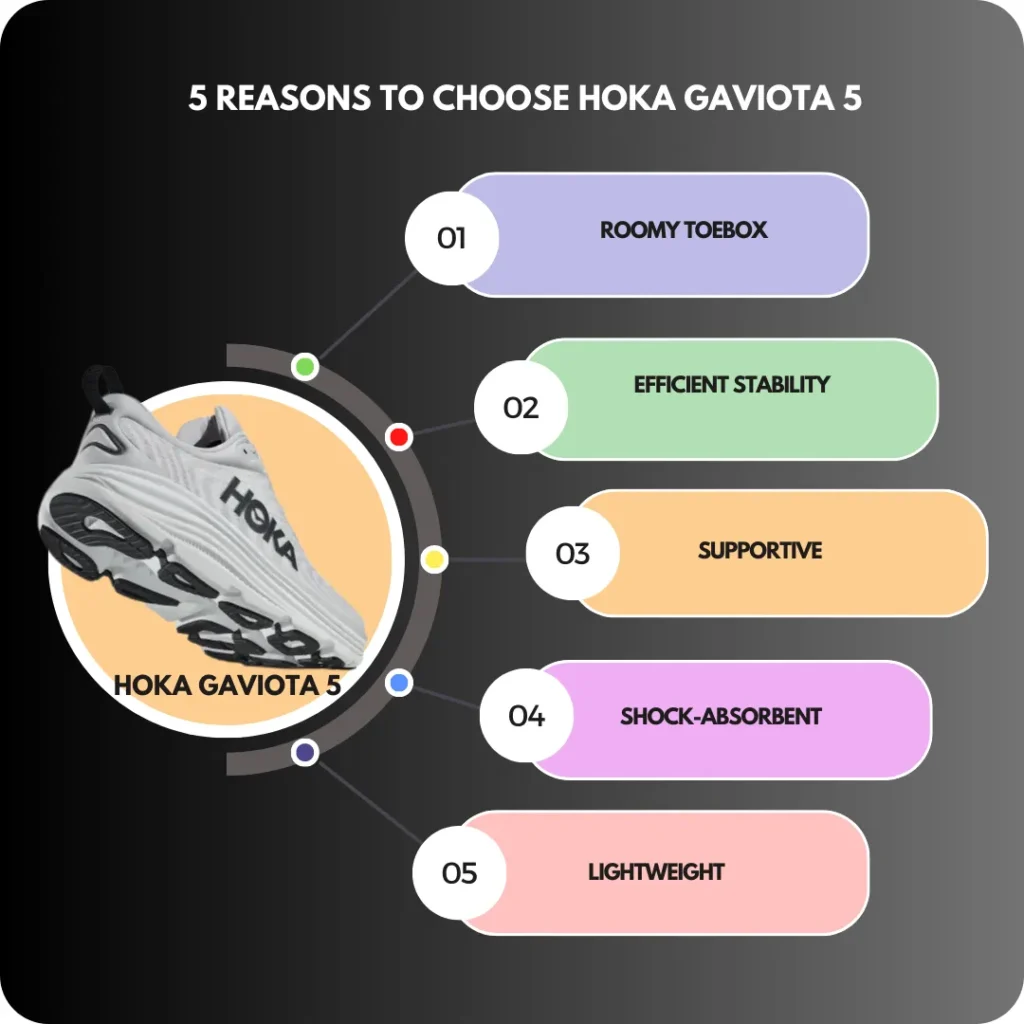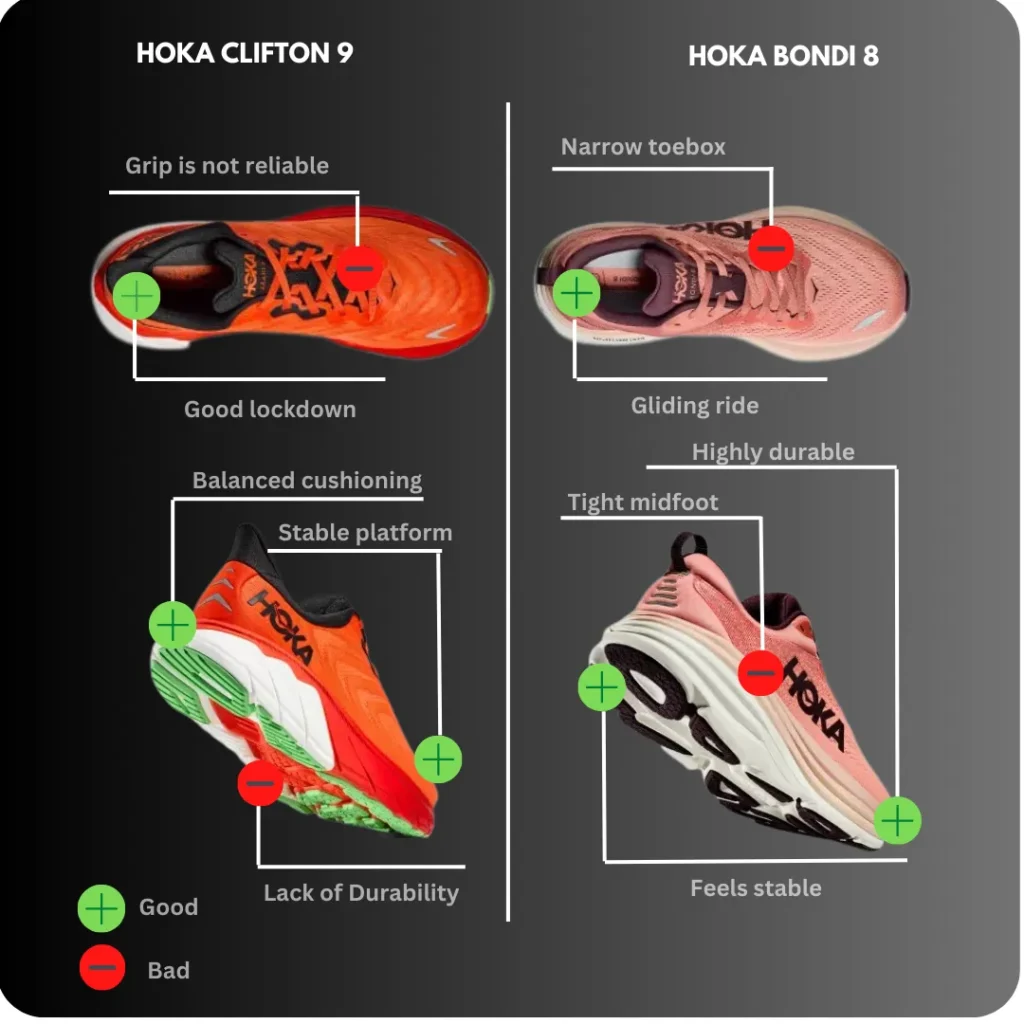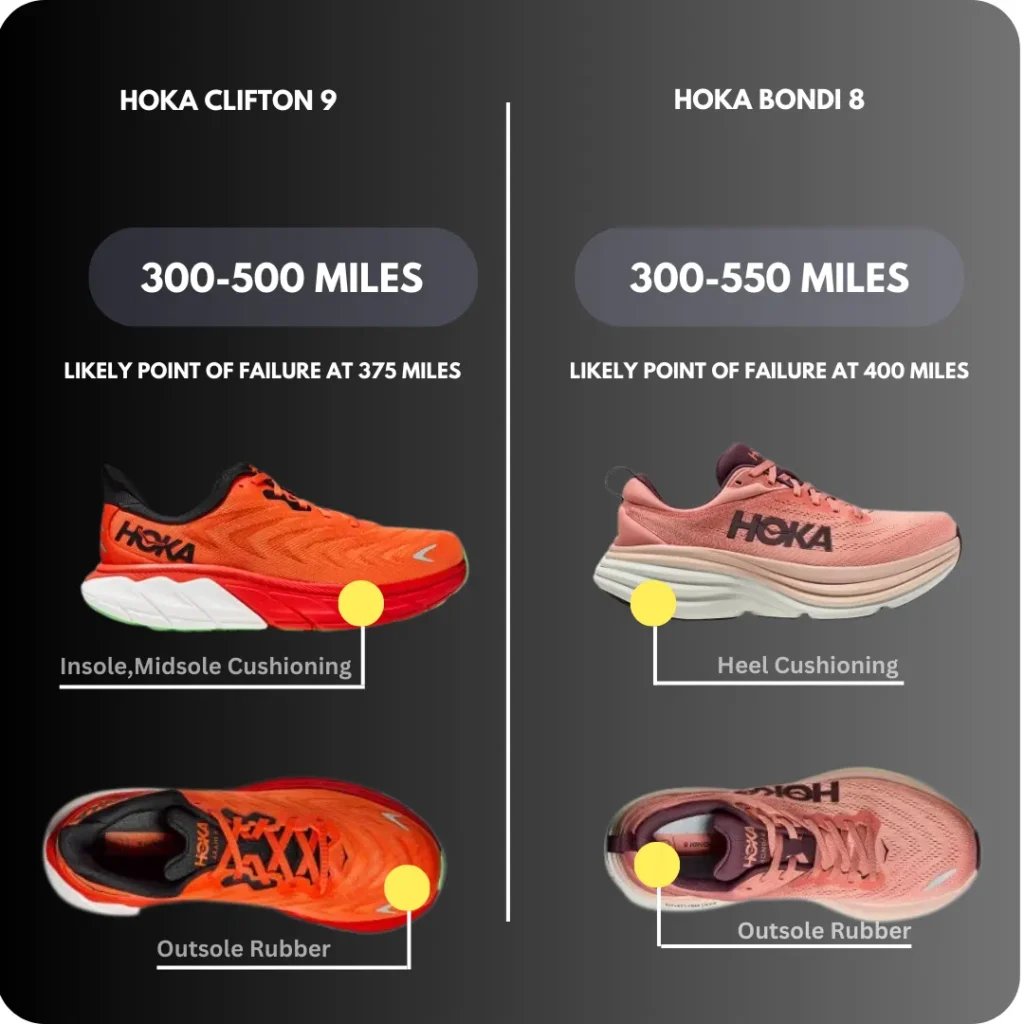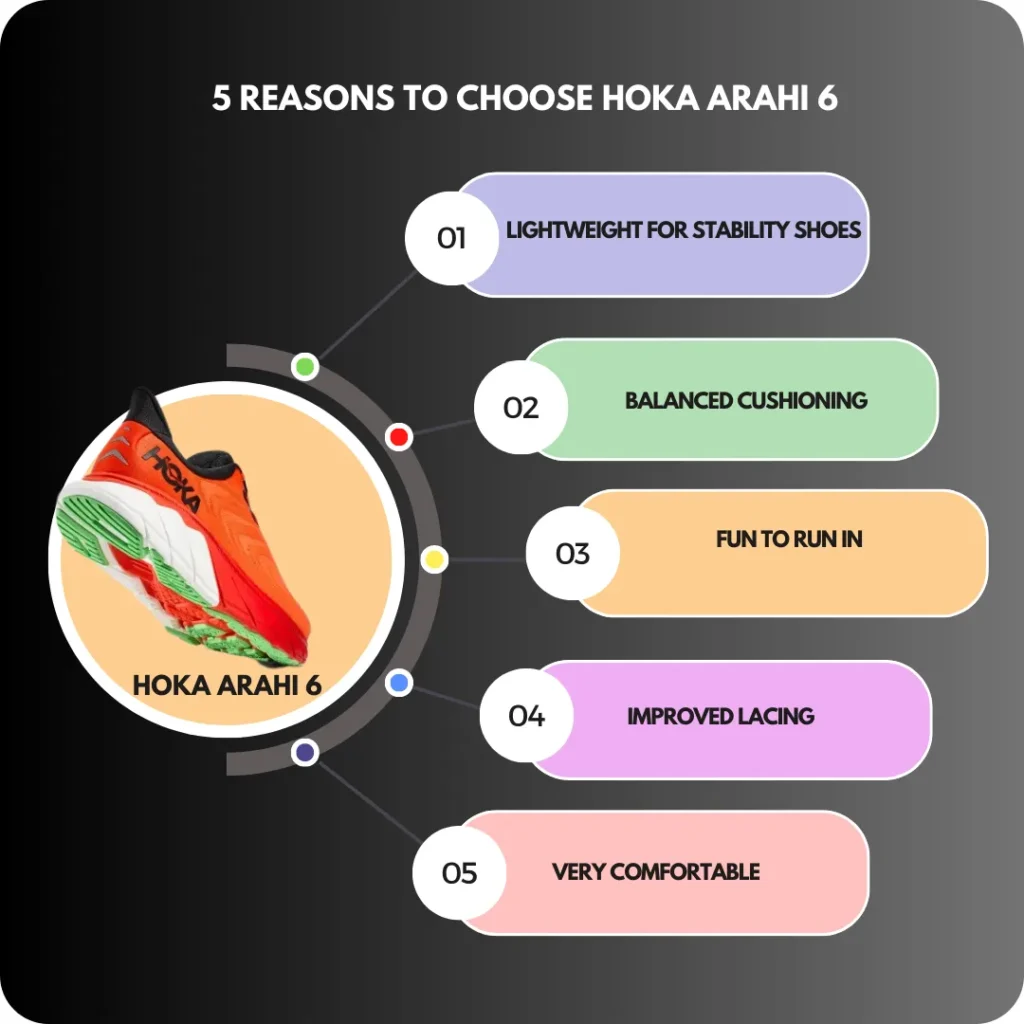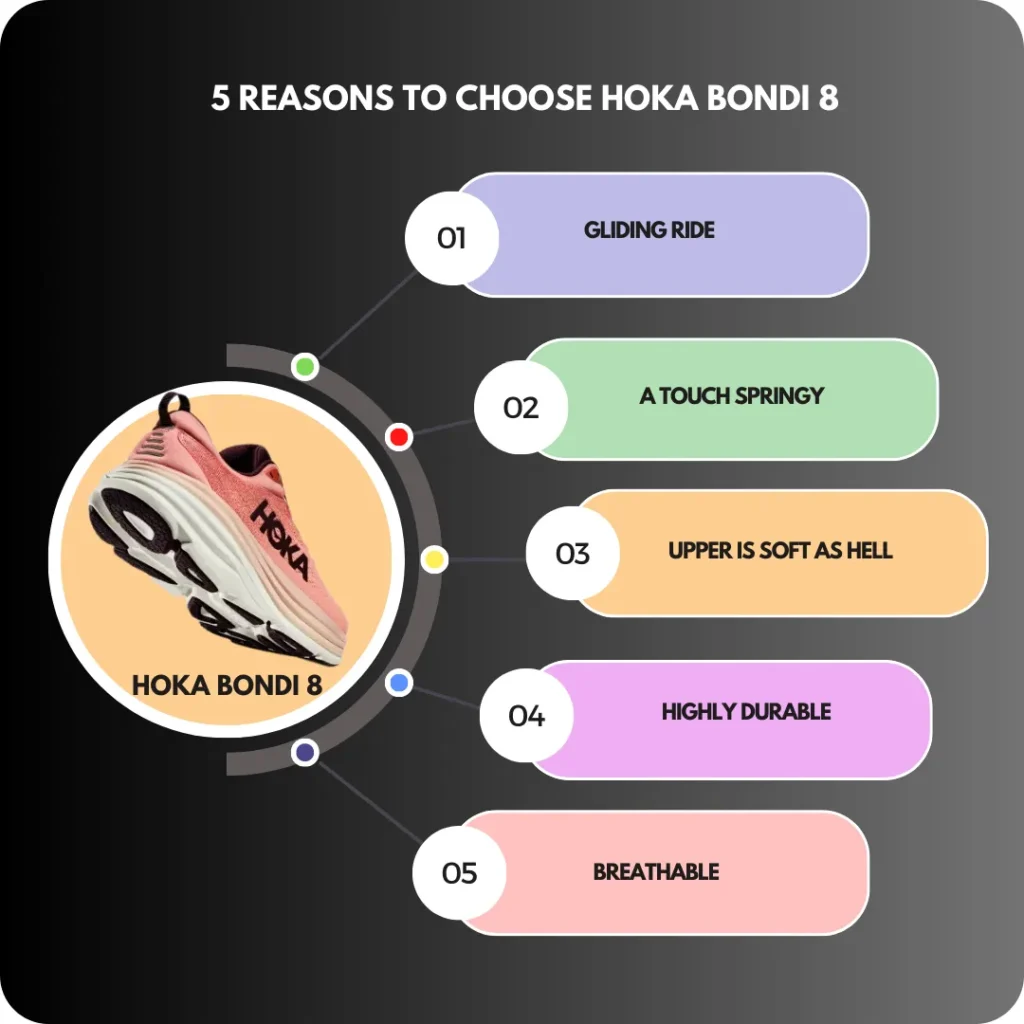Hoka Challenger 7 vs Bondi 8: Unveiling the Ultimate Running Shoe Showdown
When it comes to choosing the perfect running companion, two names frequently pop up in the conversations of avid runners and fitness enthusiasts alike – the Hoka Challenger 7 and the Bondi 8.
These two powerhouses from the renowned Hoka brand have been making waves in the running community, each with its unique set of features and promises.
In this comprehensive comparison, we dive deep into the world of running shoes to explore the nuances of the Hoka Challenger 7 and the Bondi 8, helping you make an informed decision about which one suits your running style and preferences.
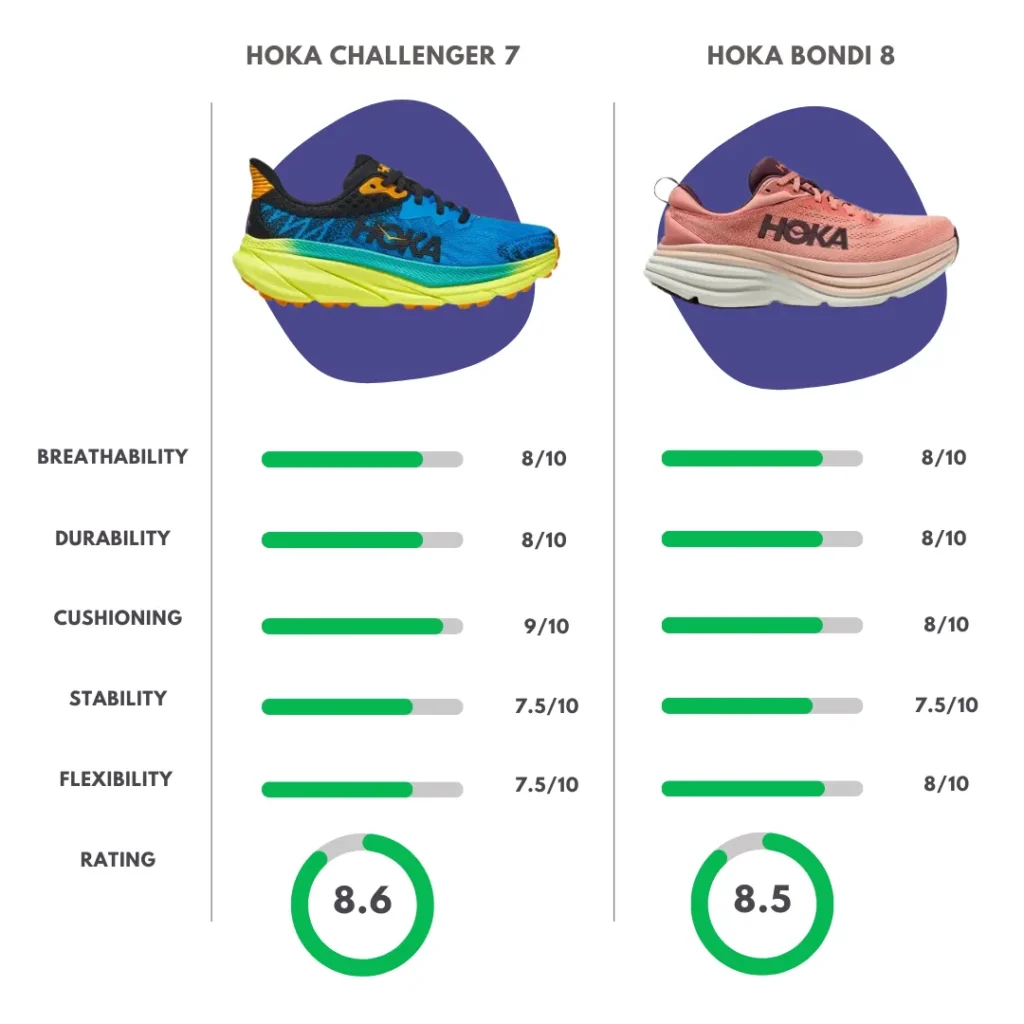
Technical Comparison Table – Hoka Challenger 7 vs Bondi 8
| Category | Hoka Challenger 7 | Hoka Bondi 8 |
| Cushioning Technology | EVA Midsole with CMEVA Foam | EVA Midsole with CMEVA Foam |
| Heel Drop | 5mm | 4mm |
| Weight | Moderate – Approx. 9.9 oz | Moderate – Approx. 10.2 oz |
| Upper Material | Engineered Mesh and Thin Overlays | Engineered Mesh and Overlays |
| Breathability | Good | Good |
| Fit | Comfortable and Supportive | Comfortable and Supportive |
| Arch Support | Neutral | Neutral |
| Outsole Material | Rubberized Foam | Rubberized Foam |
| Traction | Reliable Grip | Reliable Grip |
| Flexibility | Moderate Flexibility | Standard Flexibility |
| Pronation Control | None | None |
| Durability | Durable | Durable |
| Best Use | Versatile Running | Everyday Running |
| Recommended Distance | Short to Medium Distances | Short to Medium Distances |
| Heel Counter | External Heel Counter | External Heel Counter |
You May Also Like – Hoka Speedgoat 5 vs Challenger 7: Unveiling the Ultimate Trail Running Showdown
A Closer Look at the Hoka Challenger 7
The Hoka Challenger 7 stands tall as a formidable contender in the realm of trail running.
Designed to conquer rugged terrains and challenging landscapes, the Challenger 7 boasts an array of features tailored to elevate your off-road adventures.
Let’s delve into the key aspects that define the Challenger 7’s prowess:
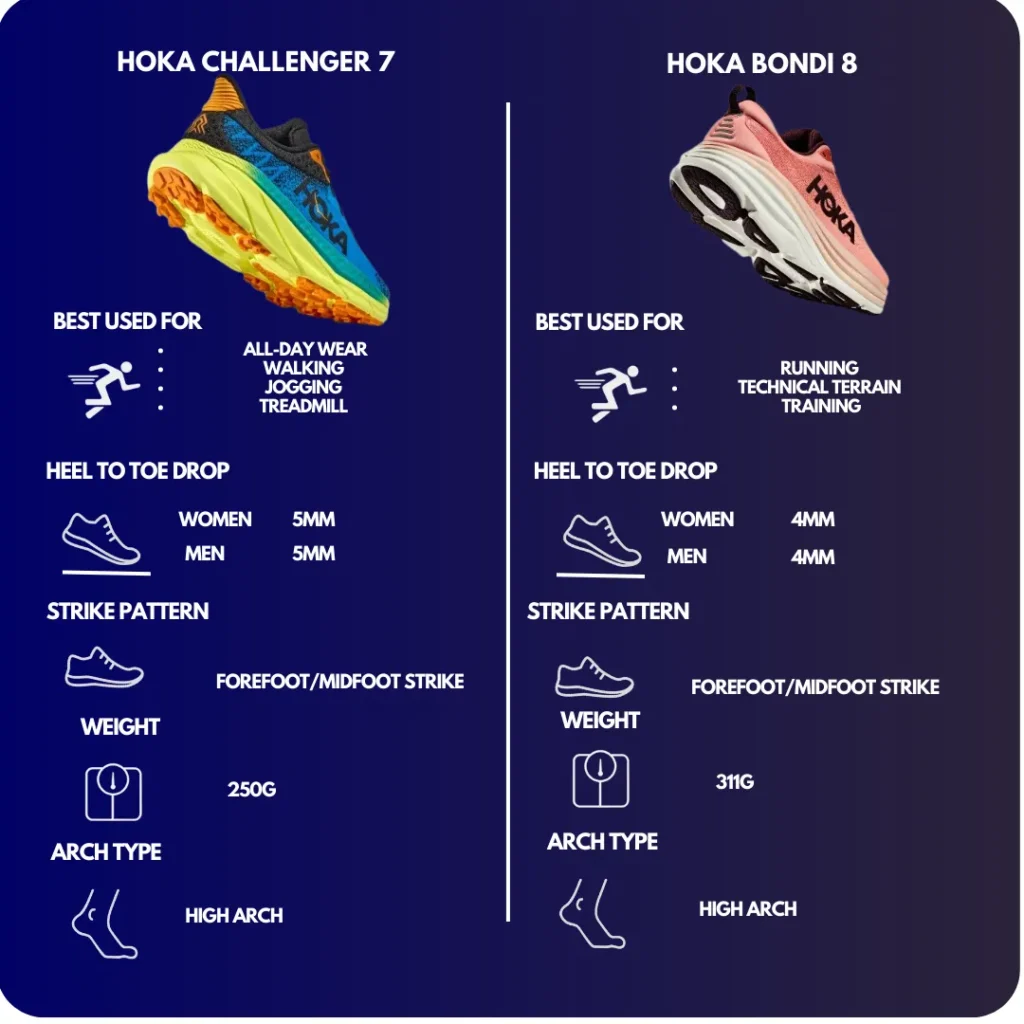
Traction and Durability
Trail running demands superior traction and durability, and the Hoka Challenger 7 answers this call with gusto.
Its outsole is engineered with multidirectional lugs strategically placed to offer exceptional grip on uneven surfaces.
Whether you’re navigating through rocky trails or tackling muddy paths, the Challenger 7’s outsole provides the stability and confidence you need to conquer the great outdoors.
Supportive Cushioning
Comfort is a non-negotiable factor in any running shoe, and the Challenger 7 doesn’t disappoint.
Equipped with Hoka’s signature cushioning technology, this shoe offers a responsive and cushioned ride.
The midsole is designed to absorb impact and provide a plush feel underfoot, ensuring a comfortable experience even during extended trail sessions.
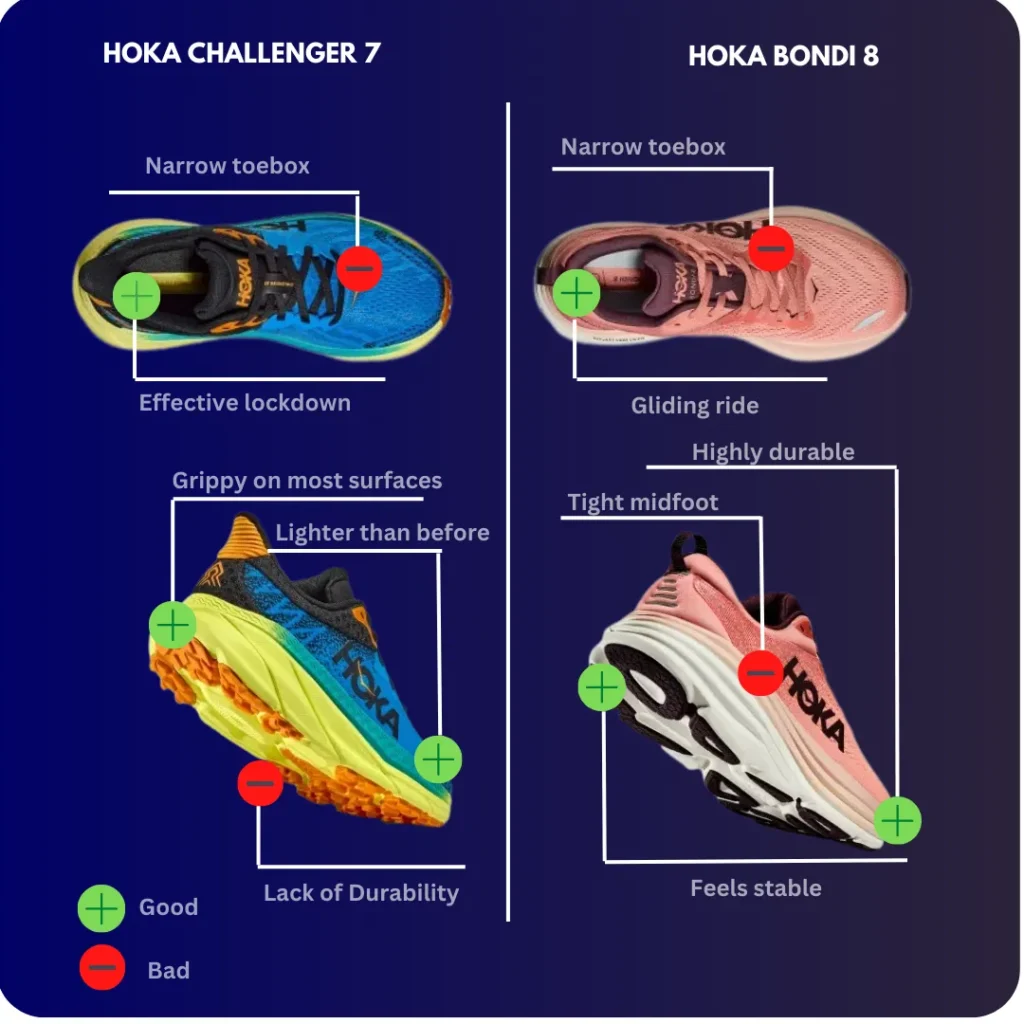
Breathable Upper
Ventilation is crucial when you’re pushing your limits on the trails, and the Challenger 7’s breathable upper ensures your feet stay cool and comfortable.
The engineered mesh construction allows for optimal airflow, preventing overheating and sweat buildup.
Also Read – Hoka One One Arahi 6 vs Bondi 8: Which is Best For You? [2023]
Unveiling the Bondi 8’s Superiority
On the other side of the spectrum, we have the Bondi 8 – a celebrated road running shoe that embodies the essence of comfort and performance.
Let’s explore the Bondi 8’s standout features that have propelled it to the forefront of road running excellence:
Plush Cushioning
If you’re seeking a cushioned and luxurious running experience, the Bondi 8 might just be your perfect match.
This shoe is revered for its maximalist cushioning that provides unparalleled comfort during road runs.
The Bondi 8’s midsole delivers a soft yet responsive feel, cushioning each step and minimizing impact on your joints.
Smooth Ride
Road running demands a smooth and efficient gait, and the Bondi 8 steps up to the plate with its Meta-Rocker technology.
This innovative design promotes a natural rolling motion, enhancing your stride efficiency and propelling you forward with each step.
Enhanced Fit and Support
A secure and supportive fit is paramount in a road running shoe, and the Bondi 8 delivers.
Its structured upper provides a snug yet accommodating fit, while the padded collar and tongue offer additional comfort and support.
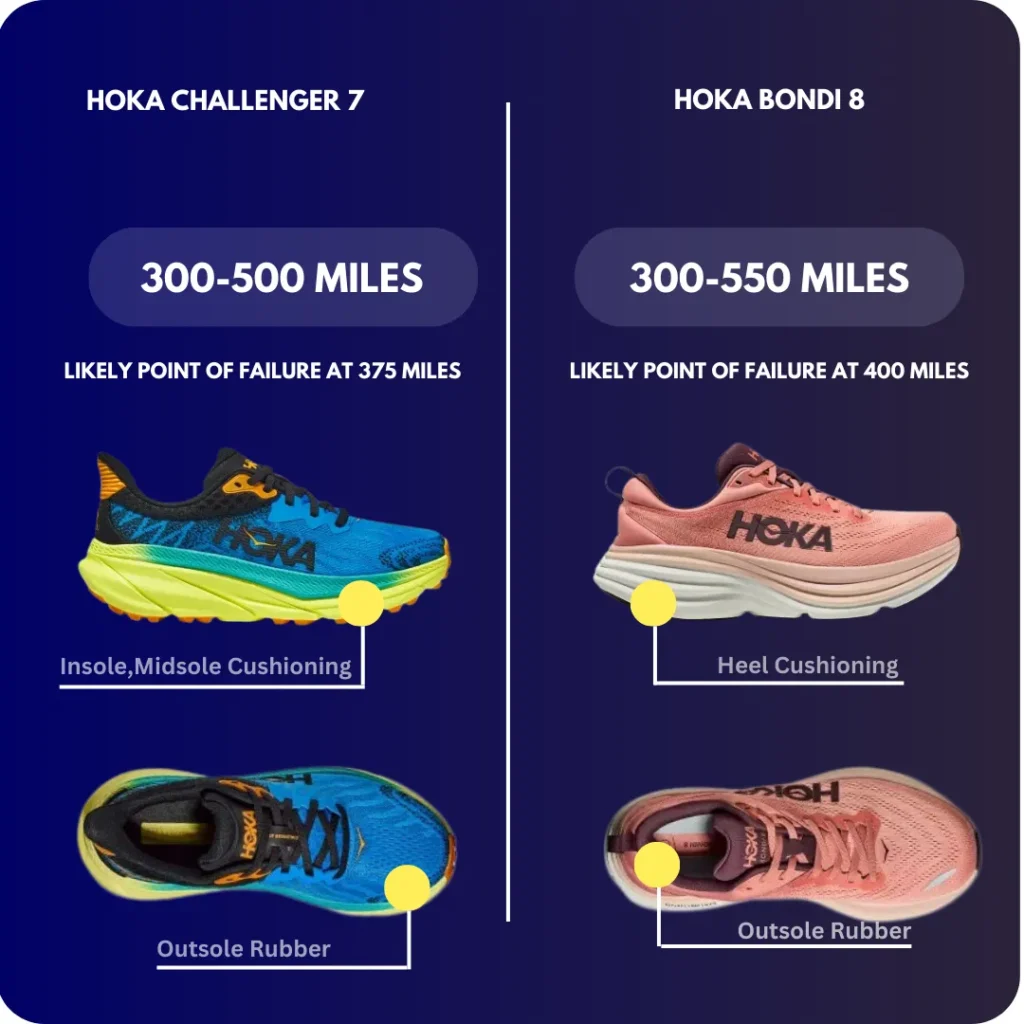
Also Read – Hoka Clifton 9 vs Bondi 8: Decoding the Ultimate Running Shoe Showdown
My Journey with the Hoka Challenger 7 and the Bondi 8,
When I first slipped into the Hoka Challenger 7, it was like stepping into a whole new dimension of trail running.
The rugged terrains I often traverse were no match for its impressive traction and durable design.
What really stood out to me was the supportive cushioning – my feet felt like they were enveloped in a cloud, even on the toughest trails.
The Challenger 7’s breathable upper was a game-changer, too – no more sweaty feet after those intense runs.
Now, let’s talk about the Bondi 8, the shoe that transformed my road running experience.
As soon as I hit the pavement, I was greeted by the Bondi 8’s plush cushioning, which seemed to absorb every impact and turn my run into a comfortable glide.
It’s like the shoe was whispering, “Keep going, I’ve got your back.” The smooth ride, thanks to the Meta-Rocker technology, made my strides feel effortless and efficient.
Plus, the enhanced fit and support of the upper kept my feet snug and secure throughout my runs.
So, which one’s my favorite?
Well, it’s like choosing between two amazing flavors of ice cream – tough call!
The Hoka Challenger 7 fuels my adventurous spirit on the trails, while the Bondi 8 turns road running into a luxurious affair.
Ultimately, my choice depends on the terrain and the kind of run I’m craving that day. Each shoe has its unique charm, and I’m grateful to have both in my collection.
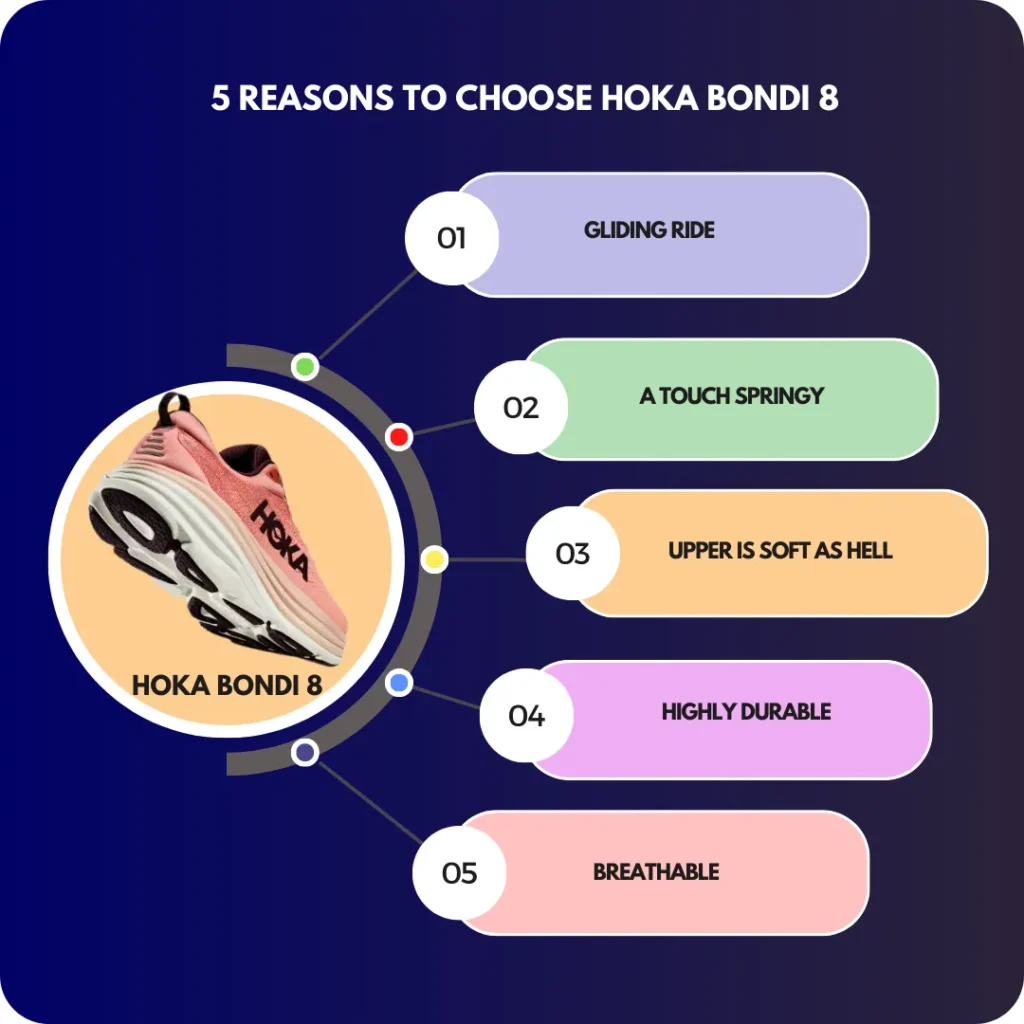
Making the Decision: Challenger 7 or Bondi 8?
As you stand at the crossroads of this running shoe dilemma, the choice ultimately boils down to your running preferences and terrain of choice.
If you’re an adventurous spirit who thrives on trail escapades, the Hoka Challenger 7’s rugged build, superior traction, and supportive cushioning make it a worthy companion. On the other hand, if you’re a road warrior seeking the ultimate in comfort and cushioning, the Bondi 8’s plush ride, smooth transition, and supportive fit might be your ideal match.
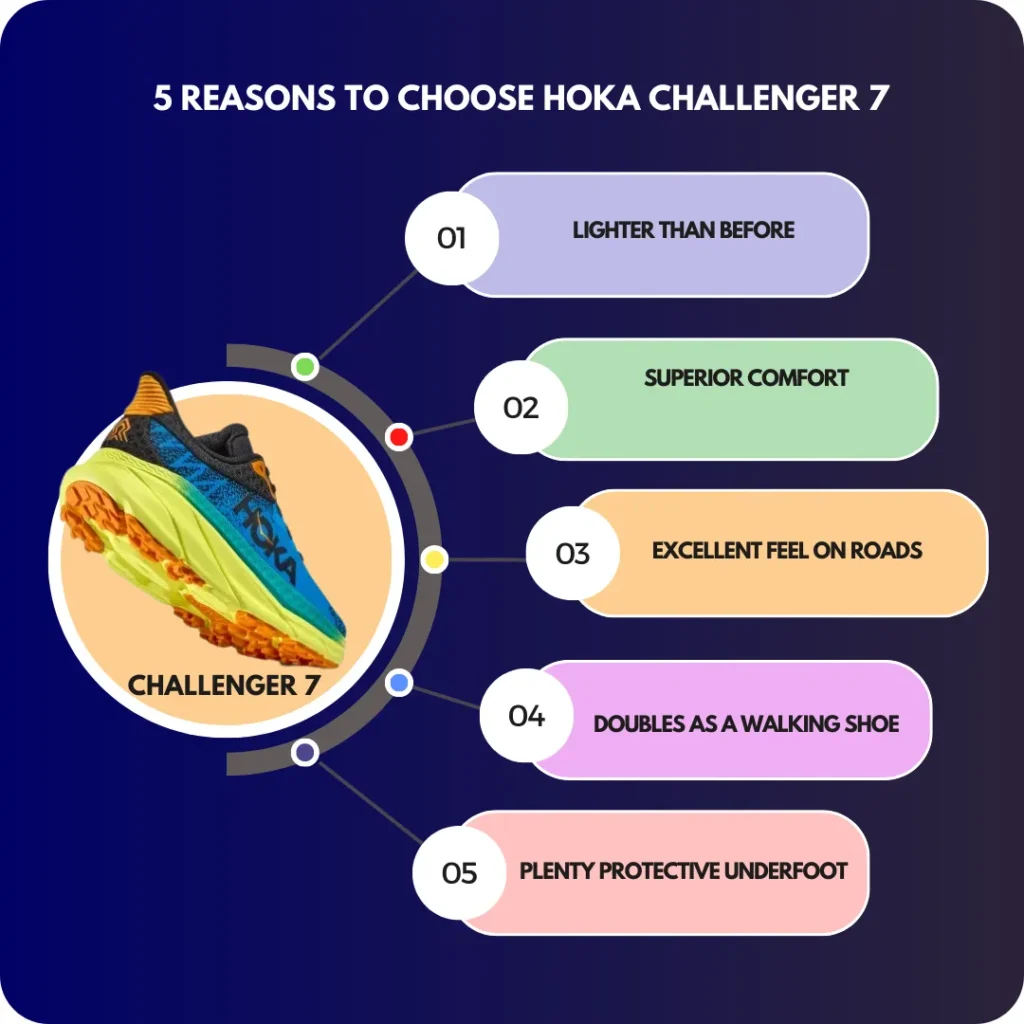
Related Comparison – Hoka Bondi 8 vs Gaviota 5: Unveiling the Ultimate Comparison
FAQs
What are the key differences between the Hoka Challenger 7 and Bondi 8?
- The Hoka Challenger 7 is designed for trail running, with rugged traction and durable construction to tackle challenging terrains.
- The Bondi 8, on the other hand, is optimized for road running, offering plush cushioning and a smooth ride on pavement.
Which type of runner is the Hoka Challenger 7 best suited for?
The Hoka Challenger 7 is ideal for trail enthusiasts and runners who love exploring off-road terrains. Its supportive cushioning and reliable traction make it a go-to choice for adventurous outdoor runs.
Who should consider the Bondi 8 for their running needs?
The Bondi 8 is a great option for road runners seeking maximum comfort and cushioning. It’s particularly well-suited for long distances and offers a smooth and luxurious ride on paved surfaces.
How does the cushioning technology differ between these two models?
- The Hoka Challenger 7 features responsive cushioning that’s tailored for trail impact, providing stability and protection on uneven surfaces.
- The Bondi 8, on the other hand, boasts plush cushioning that’s optimized for road running, delivering a comfortable and supportive experience on smoother terrains.
Can the Hoka Challenger 7 be used on roads as well?
While the Hoka Challenger 7 is primarily designed for trails, its versatile design allows it to handle some road running. However, its rugged outsole may not provide the same level of traction on pavement as it does on trails.
What kind of support do the Bondi 8 and Hoka Challenger 7 offer?
- The Hoka Challenger 7 provides excellent lateral support and stability for navigating uneven terrains, making it a reliable choice for trail runners.
- The Bondi 8 focuses on cushioning and comfort, with features that support a smooth and easy stride during road runs.
Are these shoes suitable for runners with specific foot shapes?
Both the Hoka Challenger 7 and Bondi 8 offer various width options to accommodate different foot shapes, ensuring a comfortable and secure fit for a wide range of runners.
Can I use these shoes for races and speed workouts?
- The Hoka Challenger 7 is well-suited for trail races and outdoor speed workouts, providing the necessary traction and stability for quick maneuvers.
- The Bondi 8 is more geared towards longer distances and comfortable pacing, making it a solid choice for endurance runs and recovery workouts.
How does the weight of the Hoka Challenger 7 compare to the Bondi 8?
Generally, the Hoka Challenger 7 is designed to be more lightweight and agile to navigate trails efficiently.
The Bondi 8 prioritizes cushioning and comfort, which may result in a slightly higher weight compared to the Challenger 7.
What type of terrain is the Bondi 8 best suited for?
The Bondi 8 excels on road surfaces, making it an excellent choice for urban running, track workouts, and long road runs. Its cushioning and smooth ride enhance comfort on paved terrains.
Hoka Challenger 7 vs Bondi 8: Unveiling the Ultimate Running Shoe Showdown Read More »
